4.1: Chapter 4: China and East Asia to the Ming Dynasty
- Page ID
- 253852
\( \newcommand{\vecs}[1]{\overset { \scriptstyle \rightharpoonup} {\mathbf{#1}} } \)
\( \newcommand{\vecd}[1]{\overset{-\!-\!\rightharpoonup}{\vphantom{a}\smash {#1}}} \)
\( \newcommand{\id}{\mathrm{id}}\) \( \newcommand{\Span}{\mathrm{span}}\)
( \newcommand{\kernel}{\mathrm{null}\,}\) \( \newcommand{\range}{\mathrm{range}\,}\)
\( \newcommand{\RealPart}{\mathrm{Re}}\) \( \newcommand{\ImaginaryPart}{\mathrm{Im}}\)
\( \newcommand{\Argument}{\mathrm{Arg}}\) \( \newcommand{\norm}[1]{\| #1 \|}\)
\( \newcommand{\inner}[2]{\langle #1, #2 \rangle}\)
\( \newcommand{\Span}{\mathrm{span}}\)
\( \newcommand{\id}{\mathrm{id}}\)
\( \newcommand{\Span}{\mathrm{span}}\)
\( \newcommand{\kernel}{\mathrm{null}\,}\)
\( \newcommand{\range}{\mathrm{range}\,}\)
\( \newcommand{\RealPart}{\mathrm{Re}}\)
\( \newcommand{\ImaginaryPart}{\mathrm{Im}}\)
\( \newcommand{\Argument}{\mathrm{Arg}}\)
\( \newcommand{\norm}[1]{\| #1 \|}\)
\( \newcommand{\inner}[2]{\langle #1, #2 \rangle}\)
\( \newcommand{\Span}{\mathrm{span}}\) \( \newcommand{\AA}{\unicode[.8,0]{x212B}}\)
\( \newcommand{\vectorA}[1]{\vec{#1}} % arrow\)
\( \newcommand{\vectorAt}[1]{\vec{\text{#1}}} % arrow\)
\( \newcommand{\vectorB}[1]{\overset { \scriptstyle \rightharpoonup} {\mathbf{#1}} } \)
\( \newcommand{\vectorC}[1]{\textbf{#1}} \)
\( \newcommand{\vectorD}[1]{\overrightarrow{#1}} \)
\( \newcommand{\vectorDt}[1]{\overrightarrow{\text{#1}}} \)
\( \newcommand{\vectE}[1]{\overset{-\!-\!\rightharpoonup}{\vphantom{a}\smash{\mathbf {#1}}}} \)
\( \newcommand{\vecs}[1]{\overset { \scriptstyle \rightharpoonup} {\mathbf{#1}} } \)
\( \newcommand{\vecd}[1]{\overset{-\!-\!\rightharpoonup}{\vphantom{a}\smash {#1}}} \)
\(\newcommand{\avec}{\mathbf a}\) \(\newcommand{\bvec}{\mathbf b}\) \(\newcommand{\cvec}{\mathbf c}\) \(\newcommand{\dvec}{\mathbf d}\) \(\newcommand{\dtil}{\widetilde{\mathbf d}}\) \(\newcommand{\evec}{\mathbf e}\) \(\newcommand{\fvec}{\mathbf f}\) \(\newcommand{\nvec}{\mathbf n}\) \(\newcommand{\pvec}{\mathbf p}\) \(\newcommand{\qvec}{\mathbf q}\) \(\newcommand{\svec}{\mathbf s}\) \(\newcommand{\tvec}{\mathbf t}\) \(\newcommand{\uvec}{\mathbf u}\) \(\newcommand{\vvec}{\mathbf v}\) \(\newcommand{\wvec}{\mathbf w}\) \(\newcommand{\xvec}{\mathbf x}\) \(\newcommand{\yvec}{\mathbf y}\) \(\newcommand{\zvec}{\mathbf z}\) \(\newcommand{\rvec}{\mathbf r}\) \(\newcommand{\mvec}{\mathbf m}\) \(\newcommand{\zerovec}{\mathbf 0}\) \(\newcommand{\onevec}{\mathbf 1}\) \(\newcommand{\real}{\mathbb R}\) \(\newcommand{\twovec}[2]{\left[\begin{array}{r}#1 \\ #2 \end{array}\right]}\) \(\newcommand{\ctwovec}[2]{\left[\begin{array}{c}#1 \\ #2 \end{array}\right]}\) \(\newcommand{\threevec}[3]{\left[\begin{array}{r}#1 \\ #2 \\ #3 \end{array}\right]}\) \(\newcommand{\cthreevec}[3]{\left[\begin{array}{c}#1 \\ #2 \\ #3 \end{array}\right]}\) \(\newcommand{\fourvec}[4]{\left[\begin{array}{r}#1 \\ #2 \\ #3 \\ #4 \end{array}\right]}\) \(\newcommand{\cfourvec}[4]{\left[\begin{array}{c}#1 \\ #2 \\ #3 \\ #4 \end{array}\right]}\) \(\newcommand{\fivevec}[5]{\left[\begin{array}{r}#1 \\ #2 \\ #3 \\ #4 \\ #5 \\ \end{array}\right]}\) \(\newcommand{\cfivevec}[5]{\left[\begin{array}{c}#1 \\ #2 \\ #3 \\ #4 \\ #5 \\ \end{array}\right]}\) \(\newcommand{\mattwo}[4]{\left[\begin{array}{rr}#1 \amp #2 \\ #3 \amp #4 \\ \end{array}\right]}\) \(\newcommand{\laspan}[1]{\text{Span}\{#1\}}\) \(\newcommand{\bcal}{\cal B}\) \(\newcommand{\ccal}{\cal C}\) \(\newcommand{\scal}{\cal S}\) \(\newcommand{\wcal}{\cal W}\) \(\newcommand{\ecal}{\cal E}\) \(\newcommand{\coords}[2]{\left\{#1\right\}_{#2}}\) \(\newcommand{\gray}[1]{\color{gray}{#1}}\) \(\newcommand{\lgray}[1]{\color{lightgray}{#1}}\) \(\newcommand{\rank}{\operatorname{rank}}\) \(\newcommand{\row}{\text{Row}}\) \(\newcommand{\col}{\text{Col}}\) \(\renewcommand{\row}{\text{Row}}\) \(\newcommand{\nul}{\text{Nul}}\) \(\newcommand{\var}{\text{Var}}\) \(\newcommand{\corr}{\text{corr}}\) \(\newcommand{\len}[1]{\left|#1\right|}\) \(\newcommand{\bbar}{\overline{\bvec}}\) \(\newcommand{\bhat}{\widehat{\bvec}}\) \(\newcommand{\bperp}{\bvec^\perp}\) \(\newcommand{\xhat}{\widehat{\xvec}}\) \(\newcommand{\vhat}{\widehat{\vvec}}\) \(\newcommand{\uhat}{\widehat{\uvec}}\) \(\newcommand{\what}{\widehat{\wvec}}\) \(\newcommand{\Sighat}{\widehat{\Sigma}}\) \(\newcommand{\lt}{<}\) \(\newcommand{\gt}{>}\) \(\newcommand{\amp}{&}\) \(\definecolor{fillinmathshade}{gray}{0.9}\)4.1 CHRONOLOGY
China
8000 – 2000 BCE Neolithic Cultures in China
5000 – 3000 BCE Yangshao Culture
3000 – 1900 BCE Longshan Culture
c. 1900 – 1600 BCE Xia Dynasty
c. 1600 – 1046 BCE Shang Dynasty
1045 – 256 BCE Zhou Dynasty
1045 – 771 BCE Western Zhou
770 – 256 BCE Eastern Zhou
551 – 479 BCE Confucius
475 – 221 BCE Warring States Period
221 – 210 BCE Qin Dynasty
221 – 210 BCE First Emperor of Qin
202 BCE – 220 CE Han Dynasty
141 – 87 BCE Emperor Wu
220 – 589 CE Period of Division
220 – 280 CE Three Kingdoms Period
155 – 220 CE Cao Cao
265 – 317 CE Western Jin
317 – 589 CE Northern and Southern Dynasties
581 – 618 CE Sui Dynasty
618 – 907 CE Tang Dynasty
960 – 1279 CE Song Dynasty
1271 – 1368 CE Yuan Dynasty
1215 – 1294 CE Kublai Khan
1368 – 1644 CE Ming Dynasty
Korea
c. 400 BCE – 313 CE Early Historical Period
313 – 668 CE Three Kingdoms
c. 37 BCE – 668 CE Goguryeo Dynasty
668 – 892 CE Silla Dynasty
Japan
11,000 – 500 BCE Jōmon Period
500 BCE – 250 CE Yayoi Period
250 – 600 CE Mounded Tomb Period
600 – 800 CE Asuka-Nara Period
4.2 INTRODUCTION
In 1974, farmers digging a well in a field located in north-west China uncovered fragments of a clay figurine. Little did they know, they had chanced upon what has turned out to be one of the most fascinating archaeological discoveries of the twentieth century. Subsequent excavation revealed that be-neath the fragment lay a massive underground pit filled with over seven thousand terra-cotta figurines modeling archers, infantrymen, and charioteers. Another pit contained terra-cotta cavalry and infantry units that likely composed a military guard, while a third one contained high ranking officers and war chariots in what was perhaps a command post. These three pits are part of a much larger complex of underground vaults spread across twenty-two square miles. Most importantly, a large, forested burial mound towers over the neighboring fields containing these underground armies. This is where the First Emperor of Qin [cheen] was buried after he died in 210 BCE. Although it hasn’t yet been excavated, experts believe the tomb is a microcosm of the emperor’s palace, capital city, and empire. The pits, then, contained the army protecting his realm in the afterlife. With this discovery, our understanding of how China was unified under one empire after a long period of warfare was advanced immeasurably.
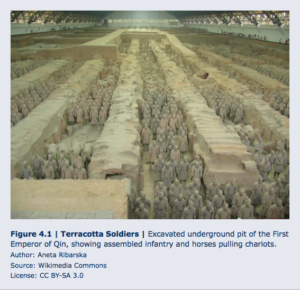
East Asia can be defined in two different ways. Geographically speaking, it can be defined as the eastern region of the Asian continent and the countries located there, principally China, North and South Korea, Taiwan, and Japan. But historians also define East Asia as a broader cultural realm, and include countries that both shared close historical relations with China and were impacted by China’s political and legal institutions, and Confucian and Buddhist traditions. When defined in this way, Vietnam is also included. This chapter, however, as an introduction to the early history of East Asia, will focus on China, Korea, and Japan.
4.3 QUESTIONS TO GUIDE YOUR READING
- During China’s Neolithic Age, how did Longshan culture differ from Yangshao culture?
- What kinds of evidence do we have to reconstruct the first dynasties in Chinese history–the Xia and Shang Dynasties? What can we learn from this evidence?
- During the Western Zhou Dynasty, how did Zhou kings justify overthrowing the Shang Dynasty, and how did they govern newly-conquered lands?
- During the Warring States Period, how did the nature of warfare change, and how did the demands of that changing warfare reshape Zhou feudal states?
- Explain the major ideas of Confucius.
- Explain the major ideas and practices of Daoism.
- Why was the Qin Dynasty so important to the history of China? What did the First Emperor of Qin accomplish?
- Describe prominent features of Han Dynasty society and governing.
- How did Buddhism become a major religious tradition in China?
- How was state development in Korea and Japan differently impacted by China?
- What were the foundations of Tang Dynasty power in East Asia?
- During the Song Dynasty, China was one of the most developed countries in the world. What features of that dynasty provide evidence supporting that judgment?
- Describe the status of women during the Song Dynasty.
- Explain the origins of the Yuan Dynasty and assess its impact on China.
4.4 KEY TERMS
- Anyang
- Asuka-Nara Period
- Cao Cao
- China proper
- Civil service examinations
- Commercialization
- Confucius and Confucianism
- Daoism
- East Asia
- Emperor Wu (Han Dynasty)
- Empress Suiko
- Footbinding
- Goguryeo Kingdom
- Imperial Confucianism
- Kublai Khan
- King Wu (Zhou Dynasty)
- Korean Peninsula
- Legalism
- Liu Bang
- Longshan culture
- Mandate of Heaven
- Mounded Tomb Period
- Neo-Confucianism
- North China Plain
- Northern and Southern Dynasties
- Oracle Bones
- Qin Dynasty
- Secondary state formation
- Shang Dynasty
- Shang Yang
- Shinto
- Silk Roads
- Silla Dynasty
- Tang Law Code
- Three Kingdoms period
- Xia Dynasty
- Yangshao culture
- Yangzi River
- Yayoi Period
- Yellow River
- Yellow Turbans
- Yuan Dynasty
- Zhao Kuangyin (Song Emperor Taizu)
- Zhou Dynasty and Western Zhou Dynasty
- Zhu Xi
4.5 GEOGRAPHY OF EAST ASIA
China’s early historical development long predated Japan’s and Korea’s, which is why a chapter on East Asian history logically begins in the second millennium BCE with China’s first dynasty. However, today’s nation of China is much larger than China was in ancient times. In earlier times, the bulk of the Chinese population lived in China proper, by which we mean the historical heartland of ancient China (see Map 4.1). To the east, China proper is bounded by the Yellow Sea, East China Sea, and South China Sea. To the south, it is bordered by the mountainous jungles of Southeast Asia. To the west and north, China is rimmed by a transitional frontier zone where land suited to agriculture gives way to mountains and plateau or vast expanses of steppe grasslands and desert. At times, the dynasties of China became actively involved in all of these neighboring areas, incorporating them directly into their expanding empires or indirectly as subordinate, tribute-paying states. Those areas include parts of the Korean Peninsula, Northeast China, Mongolia, Central Asia, and Vietnam.

Within China proper, two rivers were particularly important to the formation of agricultural commu-nities that served as the building blocks of Chinese civilization. Those were the Yellow River and Yangzi River. The Yellow River meanders through the northern half of China, where a cool, dry climate is well-suited to wheat and millet farming. Beginning far to the west, this river meanders over dusty plateau, becomes muddied with silt, and then deposits this sediment along its middle and lower reaches. The plains surrounding these reaches are collectively referred to as the NorthChina Plain. Historically, this was the heartland of Chinese civilization. However, the Yangzi River was just as important. Located in south China where the weather is relatively warmer and wetter, its long basin provided fertile soil for rice-paddy agriculture. Over time, the early dynasties expanded into and included the settled agricultural communities in this region.
Japan is an island country consisting of four main islands and many smaller ones located off the Pacific coast of the Asian continent. At 400,000 square kilometers, Japan is slightly smaller than California, although the terrain is more rugged. Because Japan is covered by mountains and traversed by numerous rivers, only fifteen percent of the land is suited to agriculture. Much of that was concentrated in two plains–the Kinai Plain and Kanto Plain–making them particularly important to Japan’s early history. Japan is also located along the Pacific Ring of Fire, where tectonic plates composing the earth’s crust frequently move and collide. That is why earthquakes and volcanic activity have been a constant threat to populations living on these islands.
The Korean Peninsula is the location of North and South Korea today. Prior to the twentieth century, however, it saw a long succession of Korean kingdoms. Extending roughly 1100 kilometers southward from the Asian landmass, the peninsula is bounded by seas to the east, west, and south, and defined by the Yalu River to the north. Beyond that lies Northeast China which was only periodically included in the territory of Chinese empires. Consequently, because the peninsula lies between China to the north and west and Japan to the east, Korean dynasties have been deeply impacted by these states’ histories and cultures. Like Japan, Korea is also mountainous, although coastal areas and plains located to the west and south were well-suited to agriculture.
The countries of East Asia share in the region’s temperate climate and summer monsoon season. During the summer months, warm and moist air originating from the Pacific flows from southeast to northwest, while during the winter months cold and dry air originating from Central Asia moves in the opposite direction. Thus, those areas of East Asia located further to the east and south are generally warmer and wetter, and for longer periods of time. That made them well-suited to rice-paddy agriculture, and rice consequently became the primary cereal crop in southern China, the Korean peninsula, and the islands of Japan. While growing rice is labor intensive, this grain also offers high yields per unit of land, so it has supported population growth in these countries and, therefore, the formation of vibrant civilizations.
4.6 CHINA FROM NEOLITHIC VILLAGE SETTLEMENTS TO THE SHANG KINGDOM
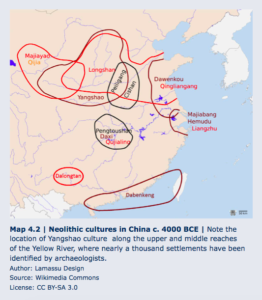
Chapters Two and Three covered the development of the first major civilizations of Mesopotamia, Egypt, and India. In each case, rivers were particularly important to that process because they offered a stable supply of water for agriculture. Similarly, in China, the first major states emerged along China’s second longest river–the Yellow River. These states are the Xia [shee-ah] Dynasty (c. 1900 – 1600 BCE), Shang [shawng] Dynasty (1600 – 1046 BCE), and Zhou [joe] Dynasty (1045 – 256 BCE). Each of these kingdoms was ruled by a line of hereditary monarchs hailing from one lineage, which is why they are also referred to as dynasties.

Because written sources don’t become available until the Shang Dynasty, historians have relied heavily on the archaeological re-cord to reconstruct the process by which these states arose. Looking back at the end of the Paleolithic era (c. 10,000 BCE), East Asia was sparsely populated by bands of foragers living in temporary settlements. During the eighth millennium BCE, in China, some of these hunter-gatherers turned to domesticated cereals for a stable food supply and settled into villages so they could cultivate them. Thus, the Neolithic Age (8000 – 2000 BCE) commenced.
Over the course of those six millennia leading up to the Xia Dynasty, Neolithic communities became more diverse and complex. For instance, for the period 5000 – 3000 BCE, archaeologists have identified at least eight major regional Neolithic cultures located along rivers and coasts (see Map 4.2). They did so by examining pottery styles and village settlement patterns. One example is Yangshao culture, which was concentrated along the middle reaches of the Yellow River. Over one thousand sites left behind by millet-farming village communities have been discovered. Jiangzhai (c. 4000 BCE), for instance, was a moated village settlement that occupied roughly thirteen acres (see Figure 4.2). It was composed of related lineages and tribal in organization.
During the third millennium BCE, Yangshao culture was gradually supplanted by Longshanculture (c. 3000 – 1900 BCE), which emerged further to the east, along the middle and lower reaches of the Yellow River. In 1928, when archaeologists excavated a site near the town after which Longshan was named, they found evidence for a culture that had laid the foundations for the kingdoms that emerged in the second millennium BCE, including the ruins of numerous walled towns with cemeteries outside (see Map 4.3). Their rammed-earth walls protected urban areas with public buildings, roads, and drainage systems. The cemetery’s arrangement suggests that people living in the towns were buried alongside clan members, but also that some members were wealthier and more powerful: while most graves had nothing but a skeleton, others contained numerous artifacts, such as pottery and jade.
Based on this evidence, archaeologists have concluded that, during the third millennium BCE, population grew and some of it shifted from villages to walled towns. These walled towns developed into political and economic centers exercising control over and serving as protection for surrounding communities. Individuals with more elaborate graves were likely political and religious leaders, and served as chieftains. Hence, numerous competing chiefdoms emerged, providing the foundation for more powerful kingdoms to follow.

Ancient Chinese histories identify the first major kingdom as the Xia Dynasty (c. 1900 – 1600 BCE). However, these were written many centuries after the kingdom about which they speak and, lacking written evidence from the dynasty itself, specialists have been unable to definitively establish its location. Nevertheless, most agree that the Xia capital was located along the Yellow River at Erlitou [are-lee-toe] (see Map 4.3). At its peak of activity from 1900 – 1600 BCE, this town looks like something more complex than a chiefdom. Erlitou included a central, walled palace complex (see Figure 4.3), workshops for the production of bronze and pottery, and elite burials containing bronze weapons and jade, suggesting a socially stratified, Bronze Age civilization and kingdom. That is why many historians identify it as the capital of the Xia Dynasty.
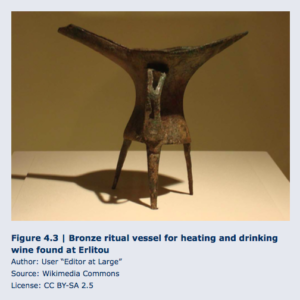
With the Shang Dynasty (1600 – 1046 BCE), we formally step into China’s historical period. In 1899, in an apothecary, a Chinese scholar came across mysterious bones that were being ground up for use as medicine. He immediately recognized that the Chinese characters inscribed on them were very ancient. Subsequently, the origin of these bones was traced to fields in Anyang [anne-yawng], China where, beginning in 1928, excavations were carried out. Similar to the discovery of the Indus Valley Civilization, a lost civilization was revealed on the North China Plain, the one difference being that traditional histories of a later time had documented this one (see Map 4.4).

The findings were substantial. A diverse array of settlements with a royal capital at the center covered nearly thirty square kilometers (see Map 4.5). Archaeologists have identified 53 pounded earth foundations as the floors of royal palace-temples and the ruins in their vicinity as residential areas for elites and commoners; sacrificial pits; and workshops for the production of bronze, pottery, and stone. Also, a royal cemetery with eight large tombs and dozens of smaller ones lies to the northwest. The larger graves were roughly half the size of a football field, each accessible through four ramps whose orientation to the cardinal directions gives them the appearance of crosses. Deep down at the bottom of each tomb’s central shaft, wooden chambers were built to house the dead bodies of Shang kings. Shockingly to us, dozens of human skeletons were placed above and below these, presumably as servants to accompany rulers in the afterlife (view reconstruction of a Xia Dynasty palace at Erlitou at the following link: http://www.waa.ox.ac.uk/XDB/images/world/tours/china-erlitou2.jpg).

Anyang, we now know, served as the last capital of the Shang Dynasty, from 1200 to 1046 BCE. It was at the center of a loosely governed territorial state located on the North China Plain. Shang kings directly governed the capital and its vicinity, but likely controlled areas farther out by building confederations with locally powerful lineage chieftains, and regularly hunting, warring, and carrying out rituals with them. Some of those leaders were directly related to the Shang kings, and some were allies by marriage.
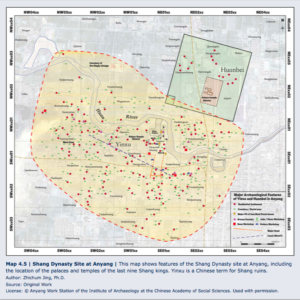
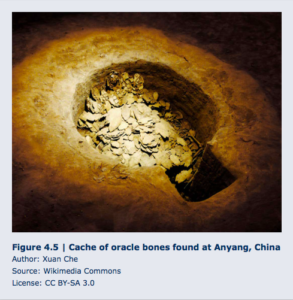
The bones are the most important source for understanding this kingdom. Most of the two hundred thousand fragments found so far are either turtle plastrons or scapula from cows. Interestingly, these were used for divination, which is why they are called oracle bones (see Figure 4.5). When Shang kings or his diviners sought to know the future, they would proceed to a temple erected in honor of a Shang deity or the spirits of deceased ancestors in the royal line. Before a stone tablet, they would make a statement about what might happen (for example, “It will rain,” or “If we attack the Mafang [high god], Di will confer assistance on us”), and then apply heat to a hole bored into a bone until it cracked. The crack was viewed as the response from the god or spirit. The king would then determine whether or not it was auspicious, and a record would be inscribed on the bone, sometimes including the actual outcome (see Figure 4.6). From these, we know that Shang elites believed that a high god Di, nature gods, and the spirits of deceased kings controlled the future. That is why Shang kings had massive bronzes cast and carried out sacrifices for them. The bronzes were filled with food and placed at the temples, literally to feed the spirits. Likewise, the sacrificial pits show that a substantial shedding of blood for these higher powers was a regular occurrence. Shang elites worshipped their ancestors and frequently divined to determine their will.
4.7 THE LONG ZHOU DYNASTY (1046 – 256 BCE)
After the Xia and Shang, the next major dynasty in Chinese history is the Zhou Dynasty (1045 – 256 BCE). In 1046 BCE, a Zhou king overthrew the last Shang ruler and established control over much of north China. In the early centuries of Zhou rule, during the Western Zhou (1046 – 771 BCE), Zhou kings dispatched kinsmen to territories he granted to them (see Map 4.6). These nobles were allowed to rule their own lands hereditarily, so long as they observed certain obligations to their king.
But over time, Zhou kings lost their ability to control these lords, and the lords became increasingly independent. In 771 BCE, in what became a telling sign of weakness, the Zhou king was murdered and his young successor was compelled to relocate farther east, to a capital closer to the heart of the North China Plain. This move marked the beginning of the Eastern Zhou (770 – 256 BCE). Over the long course of this half millennium, Zhou nobility engaged in escalating warfare with each other over matters small and large. As they did so, their lands evolved into powerful states (see Map 4.7). Eventually, the noble lords of the most powerful states also declared themselves kings, and fought to gain control over all of China. During the third century BCE, the Zhou Kingdom was destroyed and one of these warring states, the Qin [Cheen] Dynasty, prevailed over the rest.
But these centuries were not only marked by the growth of states and accelerating warfare between them. Burgeoning turmoil also inspired much thinking about what was needful to restore order and create a good society, as well as what defined the good life. Two major philosophical traditions emerged to address these issues: Confucianism and Daoism.
4.7.1 The Western Zhou Dynasty (1046 – 771 BCE)
In the eleventh century BCE, the Zhou state was a minor power on the western periphery of the Shang realm, located along the Wei [way] River. In 1059, upon witnessing five planets align, the Zhou ruler declared himself king and proceeded to engage in military conquests that made his kingdom a regional power to be reckoned with. This was King Wen (“Cultured King”), a ruler revered as the founder of the Zhou dynasty. But it was his son King Wu (“Martial King”) who brought down the Shang Dynasty. He assumed the throne upon his father’s death and, in 1046, led three-hundred chariots and 45,000 foot soldiers equipped with bronze armor and pole-mounted dagger-axes to a location just outside the Shang capital, where he met with and decisively defeated the last Shang king and his army.
King Wu then returned to his capital in the Wei River Valley, where he passed away in 1043 BCE. His young son took the throne, but was placed under the regency of Wu’s capable brother, the Duke of Zhou. Now, the Zhou royal court was faced with the task of governing newly conquered territory, including the former lands of the Shang Dynasty. The king and his regent did so by implementing three policies. First, they established a secondary capital farther east at Luoyang [low-yawng], closer to the North China Plain. Second, they issued proclamations explaining to conquered peoples why they should accept Zhou rule. According to the Duke of Zhou, Heaven had decreed that Shang kings must fall and Zhou rulers should replace them. The Shang dynasty had begun with wise and benevolent rulers, but later kings were cruel and incompetent, and failed to see to the well-being of their subjects. Thus, a dynasty once sanctioned by Heaven had lost this sanction; now, Heaven had called upon Zhou rulers to overthrow the Shang dynasty and initiate a new era of just rule. This political theory, which is known as the Mandate of Heaven, would also be used by founders of later dynasties to justify their actions, as well as by theorists to explain the rise and fall of dynasties.
The third policy the Zhou court adopted was to dispatch royal kinsmen to strategically critical locations for the purpose of establishing colonies. At their royal palaces, Zhou kings conducted ceremonies of investiture during which they sacrificed to Heaven and the spirits of deceased ancestors, held banquets, and then bestowed noble titles and grants of land upon members of the royal family and relatives by marriage. Large bronzes were cast to commemorate these occasions (see Figure 4.7). These lords– dukes, marquis, earls, and barons–then took their families, contingents of soldiers, and emblems of nobility to the granted territory and set up palaces and ancestral temples in walled towns. From there, these illustrious lineages governed a predominantly rural population of farmers living in villages where life was not easy. Living in hovels and with little opportunity to leave their lord’s manors, these farmers were required to work his lands and also to submit a portion of the harvest from their own small farms.

Historians call this method of governing Zhou kinship feudalism. Feudalism generally describes a political and economic system characterized by fragmented authority, a set of obligations (usually of a military nature) between lords and vassals, and grants of land (“fiefs”) by rulers in exchange for some type of service (see Chapters Three and Twelve). Indeed, Zhou kings granted land and noble titles to kinsmen in exchange for obedience, periodic visits to the king’s palace, tribute, and military support. However, aside from the presence of royal overseers, a hereditary lord enjoyed relative sovereignty in his own domain. The glue that held the Zhou feudal order together was deference to the king and his Mandate and reverence for their shared history–including, most importantly, the deceased spirits of their related ancestors.
Over time, however, Zhou kinship feudalism failed to function as intended by the founding rulers. In brief, Zhou kings’ ability to control the noble lords diminished over time, and their prestige suffered accordingly. There were two principal reasons for this. First, ties of kinship so crucial to the founding of Zhou lost their meaning over time. In later generations, lords simply became more interested in and identified with their own territories, and they had little sense of solidarity with what were at best distant cousins ruling neighboring feudal states. Hence, it is hardly surprising that histories inform us that the many lords ceased to pay visits to the king’s court. Second, Zhou kings were unable to impose their will on feuding feudal lords and were even defeated by them in several military campaigns. In 771 BCE, for instance, King You [yo] was attacked by the allied forces of the lord of Shen and tribal peoples residing out west. The capital was sacked, and he was killed. Other states came to the rescue, relocating the king’s son, Prince Ping, to the eastern capital at Luoyang. Zhou kings remained there for the next five hundred years, during the period called the Eastern Zhou.

4.7.2 The Eastern Zhou Dynasty (770 – 256 BCE) and the Warring States Period (c. 475 – 221 BCE)
When King Ping was relocated to Luoyang, he ruled from a much smaller royal domain surrounded by approximately 150 feudal states and their lords. His and his successors’ power was, however, much reduced. No longer able to impose their will on unruly noble lineages, Zhou kings failed to maintain a semblance of peace and order throughout the realm. Instead, this warrior nobility engaged in an escalating contest for power and prestige. By 475 BCE, in the wake of 540 wars fought over the course of two centuries, only fifteen states remained (see Map 4.7). But they fought even more fiercely. Over the next 250 years, during what is referred to as the Warring States Period (475 – 221 BCE), these states averaged one major battle per year until, at the very end, only one remained standing. That was the state of Qin [cheen]. The Warring States period ended in 221 BCE when the Qin ruler defeated the remaining states and unified the former Zhou realm, initiating a new period in China’s history. The line of Zhou kings had, however, already been extinguished in 256 BCE, so that date marks the end of the Eastern Zhou Dynasty.
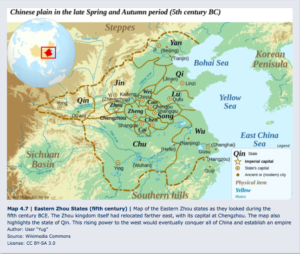
As the frequency and scale of warfare escalated, and states gradually gobbled each other up, the way feudal lords governed their states and conducted military campaigns changed. Prior to the Warring States Period, Zhou kings were still accorded a level of respect, at least as symbols of unity and nominal heads of the Zhou feudal order. At this point, the many lords had no intention of toppling the king; rather, seeing his military weakness, the most powerful ones stepped in to enforce order. The first was Duke Huan of Qi [who-an of chee]. He held this title (“duke”) and fief (Qi) because his distant ancestor had served as a commander under King Wu during the Zhou founding. Now, many generations later, his state was a formidable power on the east coast. In 651 BCE, he convened an interstate meeting with other lords to discuss matters of order and security. Upon being elected as their leader, the Zhou king conferred the title of hegemon. In this capacity, Duke Huan had the authority to resolve disputes between nobles on behalf of the king.
Over the next two centuries, this title changed hands several times, going to the lord of the most powerful state. These hegemons periodically convened interstate meetings to manage such matters as misbehaving states or foreign invasions. Attending lords cemented their agreements by swearing oaths and drinking the blood of sacrificed animals. Yet, although hegemons maintained a semblance of order, warfare remained constant because it was a way of life for the illustrious lineages of the Zhou realm. Noble lords loved to demonstrate their prowess and raise their prestige through success in hunting and battling. A noble looked for a pretext to engage in a vendetta with another lord, at which point a battle was arranged and then carried out according to the protocols of chivalry. After announcing the impending campaign at the ancestral temple, a lord and his kinsmen, accompanied by farmer foot soldiers, would proceed in their chariots to a prearranged location and engage in a skirmish. In victory, a noble redressed matters of honor and brought glory to his ancestors, something symbolized by the mound of dead enemies placed by his ancestral temple.
However, with the onset of the Warring States Period in the fifth century BCE, the level of violence was no longer contained by the hegemon system and codes of chivalry. Both the purpose and conduct of warfare changed. Lords of the seven most powerful states lost respect for the Zhou kings and even assumed the same title, thus claiming the right to unify all of China under their rule. As opposed to serving a lesson to and resolving some dispute with another lord, these self-declared kings waged war to destroy them and take their land.
Hence, battles became increasingly bloody and bitter, and victory went to those kings who could field the most effective killing machines. Chariot-riding kinsmen and a few thousand foot soldiers no longer met that requirement. During the Warring States, rulers introduced large armies composed of mass infantry and cavalry. Soldiers were equipped with armor, crossbows, halberds, dagger-axes, and swords manufactured from bronze, iron, leather, and wood in royal workshops located at capital cities. (View the image of a Warring States Period soldier at the following link: http://brandonqindynasty.weebly.com/uploads/1/0/3/9/10391259/8580061.jpeg. One description of an elite soldier states that he wears heavy armor, shoulders a large crossbow and fifty arrows, straps a halberd to his back, buckles a helmet to his head, and places a sword to his side.) Kings also militarized their kingdoms’ landscapes by building forts at strategically critical passes, walls to mark off boundaries, and watch towers to signal the enemy’s approach. Finally, these rulers no longer relied solely on close kinsmen to wage war alongside them. Rather, they created a class of military commanders and specialists whose promotion was based on their ability to produce victories in the field. It is therefore not surprising that during this time some of China’s greatest military treatises were written, most notably the Art of War by Master Sun [sue-in]. Master Sun was a military commander and strategist who served the lords of the state of Wu just prior to the onset of the Warring States period (c. fifth century BCE). The manual of military strategy and tactics attributed to him stresses the importance of formulating a strategy that insures victory prior to any campaigning. Stratagem is critical. “All warfare is deception,” Master Sun states. “Hence, when able to attack, we must seem unable; when using our forces, we must seem inactive; when we are near, we must make the enemy believe we are far away; when far away, we must make him believe we are near.”
To mobilize large numbers of men for war and supply them with weapons and grain, kings devised ways to make their realms more productive and compliant with their will. Prior to the Warring States Period, it was the norm for nobility to hand out land in their states to kinsmen, just as it had been for the king during the Western Zhou. This practice meant that lesser but related aristocratic lineages lived in estates across each noble’s territory, while also serving as ministers at his court. For a king, however, these men might become an obstacle or pose a threat because they held this land hereditarily. Therefore, they devised better ways to control land in their realms. Whenever new territory was added or a noble line was extinguished, kings created counties and appointed magistrates to manage the villages and towns in that area. The magistrate’s job would then be to register the population, maintain law and order, collect tax revenue, and conscript people for labor projects and military campaigns. And rather than give those posts to kinsmen, kings appointed men from the lower ranks of the nobility or commoners based on their loyalty and merit. Stated more simply, Warring States Period rulers created administrative units and a civil service. Their embryonic bureaucracies included such features as a system of official posts, salaries paid in grain and gifts, administrative codes, and methods for measuring a servant’s performance. Thus, by the end of this period, largely owing to the demands of warfare, the Zhou feudal order had been supplanted by a small number of powerful territorial states with centralized monarchies. Among them, the most successful was the state of Qin, which eventually conquered all of China and became an empire. We return to that topic after reviewing the ideas put forward by philosophers in the context of these centuries of turmoil.
4.7.3 Philosophy in a Time of Turmoil: Confucianism and Daoism
China’s three major pre-modern philosophical and religious traditions are Confucianism, Daoism, and Buddhism. The first two had their origins in the later centuries of the Eastern Zhou, while Buddhism only began to arrive from South Asia in the first century C.E. Confucianism and Daoism were both responses to the crisis presented by the breakdown of the Zhou feudal order and escalating warfare in China.
4.7.3.1: Confucius and Confucianism
Confucius lived just prior to the Warring States Period (551-479 BCE). What little we know about his life comes primarily from the Analects, a record of conversations Confucius held with his students compiled after he died. In later centuries, in China, Confucius was revered as a sage and teacher, and even today outside of China some people might think of him as a stern pedant, perhaps calling to mind sayings beginning with “The Master said.” However, in the context of his time, Confucius was anything but stiff and rather a dynamic individual who believed he was mandated by Heaven to return the world to a more socially and politically harmonious time. The Analects not only shows a serious and learned man, but also someone capable in archery and horsemanship, who loved music and ritual, and who untiringly travelled the feudal states in the hopes of serving in a lord’s retinue (see Figure 4.8). According to one passage, a lord once asked one of Confucius’s students about his master, but the student fell silent. Later, Confucius asked him, “Why did you not say: As a man, when agitated in thought he forgets to eat, joyfully forgetting his cares, not realizing that old age is near at hand?”

Confucius was born to a family of minor nobility and modest means in the feudal state of Lu. His father died about the time Confucius was born, and he was raised by his mother, who also passed away when Confucius was young. Like other young men of similar background, he had access to an education and could aspire to serve in some capacity in a feudal state, perhaps at the lord’s court, or as an official or soldier. Confucius chose to become learned and seek office. To his mind, he was living at a time when civilization was collapsing and society was decaying. He believed that, during the early Zhou, the nobility was honorable, observed moral codes, and upheld social standards. He believed that a golden age existed in the past and wished to transmit the ethical values of that time. However, in the course of doing so, he reinterpreted the past and imbued the virtues he stressed with rich, new meanings. Here are a few of the important statements Confucius made, and what they meant:
1. “The noble person is concerned with rightness, the small person is concerned with profit.” (4.16) Confucius redefined the meaning of nobility. For him, nobility was defined not by birth but rather by character and conduct. A truly noble person is one who puts what is right before personal gain and the desire for wealth and fame.
2. “Young men should be filial at home and respectful to their elders when away from home.” (1.6) Filial piety is central to Confucius’s thought. He taught how a person becomes moral because a good society only develops when composed of and led by virtuous people. He saw the practice of morality in the family as the root. Should a young man learn to be respectful and reverent towards parents and elders, he will become a humane person, and humane people are far more likely to contribute in a positive way to society.
3. “The noble man does not abandon humaneness for so much as the space of a meal.” (4.5) For Confucius, the highest virtue is humanity, and many of his conversations center upon defining what it is that makes a person humane. A person of humanity is, for instance, one who is capable of empathy and unselfish concern for the welfare of others. They know the golden rule: “what you would not want for yourself,” he taught, “do not do to others.” (15.23) Confucius emphasized that a society cannot function if people are incapable of taking other’s perspectives and doing their best for them. In addition, he insisted that such virtues as humanity are most fully demonstrated when individuals observe good etiquette. Decorum was important to Confucius.
4. “Heaven has given birth to the virtue that is in me.”[1] (7.22) Interpreters of Confucius have rightly noted that he is quite silent about the supernatural and what happens after death, rather emphasizing the life we have and serving others. Yet, it would be wrong to conclude that he wasn’t religious in any sense, because he frequently spoke of Heaven. He believed that Heaven ordains a certain course of life for each individual, including becoming a moral person. This Heaven, however, is less a deity than a higher moral order, a kind of beneficent presence.
5. “To govern is to rectify. If you lead the people by being rectified yourself, who will dare not be rectified?” (12.17) Confucius believed that good governing flows from good men. The first qualification for a ruler or one who serves is moral rectitude. If those who lead do so by virtue and conduct themselves according to rules of propriety, people will learn from them and develop a sense of honor and shame. Consequently, society will become more orderly.
The noble person, filial piety, humaneness, etiquette, Heaven, and government by men of virtue are just some of the ideas Confucius discussed as he traveled the feudal states seeking to advise their lords. However, he only managed to hold some minor offices in Lu and generally failed in his political aspirations. Instead, he gained an avid following of 70 students, whom he accepted regardless of their social status. After he died, they passed on his teachings, and a school of thought emerged from his teachings known as Confucianism. Those who belonged to it are Confucians–individuals distinguished by their commitment to the ideas articulated by Confucius, classical learning, and the value they place on character and conduct as the key to a good society and political order.
4.7.3.2: Philosophical and Institutional Daoism
During the turmoil of the Warring States period, however, other individuals developed a philosophy very different from Confucianism called Daoism. These Daoists largely rejected Confucian ideas about human moral development and social order as artificial constructs. Rather, they pointed to a natural condition that both individuals and society can recover, one that existed before desires trapped people in a world of strife. Their central concept is the Dao (“Way”). The Dao is mysterious: it is beyond sense perception and yet the source of life and the universe, the ultimate truth transcending the polarities that make up life and yet pervades them, empty and yet the mother of all things.
Paradoxically, although the Dao is indescribable and can’t be seen or heard, the goal of the Daoist is to accord with and follow it. But this goal won’t be accomplished through more seeking and more knowledge. Rather, the mind must be emptied primordial, natural condition is restored. At that point, when the individual is in accord with the ineffable Way, life becomes spontaneous, natural, and effortless. The two most important early books belonging to this tradition are named after their putative authors: the Laozi (“Old Master”) and Zhuangzi (“Master Zhuang”). invented by Warring States Period philosophers who compiled the book attributed to him. Master Zhuang, however, lived during the fourth century BCE.

In later centuries, the Daoism of these early philosophers was taken in new directions. The idea that individuals have a spiritual essence in need of harmonizing and liberation. By so doing, it was believed, one’s health would be preserved and life prolonged. Daoists even entertained the idea that one could become immortal. To achieve these goals, techniques were developed, including special dietary regimens, yoga, Chinese boxing, meditation, and alchemy. religion. Daoist masters, claiming divine inspiration, composed esoteric texts for their followers. These texts explained how the natural world originated from a primordial ether (qi) and its division into two polar forces: the yin and yang (see Figure 4.9). They presented a universe with multiple heavenly and hellish realms populated with divinities and demons. The principal purpose of these Daoists was to attend to a person’s physical and psychological well-being. That involved not only teaching individual techniques for preserving the life spirit, but also the use of exorcism rituals that could cure illness, free souls from hell, win blessings from heaven, and eliminate sins from the community. Eventually, a Daoist church developed, with its own ordained priesthood, temples, and monasteries.
4.8 THE QIN DYNASTY AND THE TRANSITION FROM ANCIENT TO IMPERIAL CHINA
In 219 BCE, while touring his realm, the First Emperor of Qin [cheen] (259 – 210 BCE) erected a stone tablet atop a mountain with an inscription proclaiming:
They [the Qin ministers] recall and contemplate the times of chaos:
When [regional lords] apportioned the land, established their states,
And thus unfolded the pattern of struggle.
Attacks and campaigns were daily waged;
They shed their blood in the open countryside. . . .
Now today, the August Emperor has unified All-under-Heaven into one family— Warfare will not arise again!
Disaster and harm are exterminated and erased,
The black-headed people live in peace and stability, benefits and blessings are lasting and enduring.[2]

Indeed, just two years prior, in 221 BCE, the First Emperor had brought the Warring States Period to a close by defeating the last remaining state. Hence, he had realized the aspi-rations held by the ma-ny rulers he subjugated, that is, to unify the known world under one powerful monarch and, by so do-ing, to initiate an age of peace and prosperity, one rooted in obedience to a sagely ruler.
The title “First Emper-or of Qin,” however, was assumed by this conquer-or only in the wake of his final victory, and it made sense. Having crushed the many warring kingdoms, the First Emperor did in-deed create something new and more significant: an immense territorial state centrally administered from his capital, by a monarch with unchallenged sovereignty (see Map 4.8). So how did his state–the Qin kingdom–prevail?
When the First Emperor inherited the Qin throne at the age of 13 in 246 BCE, he became King Zheng [jung], young ruler of the most powerful of the seven remaining Warring States. Looking back, he would understand that he had inherited a state whose origins dated back to the Western Zhou Period, when land to the west of the Zhou kings was granted as a fief to his chieftain forbears. The Qin star first rose when a Qin lord assisted King Ping in relocating to the eastern capital during the transition from the Western to the Eastern Zhou Period (c. 770 BCE). At that time, the old Zhou heartland was granted to him, and he was elevated to the status of a regional lord, the Duke of Qin.

The Dukes of Qin were important players throughout the centuries of warfare and alliances so characteristic of the Eastern Zhou, and especially after the reforms of Duke Xiao [she-ow] (r. 361 – 338). These reforms were based on the advice of his chancellor Shang Yang [shawng yawng], an individual famed for being one of the founders of another major intellectual tradition that developed during the Warring States Period: Legalism. The legalists were in tune with the efforts rulers were putting forth to strengthen their states. Their goal was to devise the best techniques for organizing a state’s territory and people so as to maximize a ruler’s power and control in times of both war and peace. Legalists believed that the best way to do so was to concentrate authority in one central administration governed by an absolute monarch.
To these ends, Shang Yang introduced many measures, laying the foundations for future Qin greatness. He believed that the basis for state power lay with an obedient and disciplined farming population, because that was the principal source of revenue and conscripts for the army. So he organized villages across the land into units of five families each, and made the members of each unit responsible for each other. Every member would be rewarded based on the amount of grain the unit produced or the number of severed heads returned from the battlefield. For meritorious service to the state, a unit could advance along a system of ranks, each of which bestowed certain privileges. But should any member commit a crime, everyone would be severely punished. To make this more effective, the Qin state developed a legal code with clear lists of penalties for specific crimes, made it publicly available, and applied it uniformly to people regardless of their social status. Also, the Qin was among the most effective in establishing a civil service and county system to administer the law. Qin subjects lived under a regime with a transparent set of expectations, and also a system of rewards and punishments. Such rationality in matters of efficiently organizing a state through the uniform application of laws and regularizing administration, as implemented by Shang Yang, were a mark of legalist thinkers’ methods.
After Duke Xiao’s and Shang Yang’s time, Qin rulers assumed the title of king and engaged in numerous battles, destroying several neighboring states. Some of these were major engagements. According to one account, after the Qin kingdom defeated the state of Zhao, a Qin general ordered 400,000 captured soldiers buried alive. Also, the Qin put an end to the Zhou royal line after conquering their territory in 256 BCE. Hence, King Zheng was heir to a kingdom whose success in battle derived in part from legalist reforms. In line with that tradition, he too employed a legalist advisor.

As of 230 BCE, only six other Warring States remained (see Map 4.9). Over the next decade, King Zheng led a series of massive campaigns each of which over one hundred thousand soldiers. This was a bloody time, as one state after another fell. By 221 BCE, the Chinese realm was unified under Qin rule.
Although the Qin Dynasty (221 – 207 BCE) was brief-lived, it had a lasting effect on China because of the stable administrative foundation it laid. The First Emperor of Qin and his advisors invented the title used by all subsequent rulers. They made newly conquered territory a part of their centralized bureaucracy. From his royal court and central administration, the emperor governed a land organized into a hierarchical system of commanderies (provinces that began as military outposts) and counties. His regime standardized currency and the system of writing, and issued regulations for uniform weights and measures.
The emperor was also a great builder. Over 6800 kilometers of road were laid to connect the capital at Xianyang to each province and the northern border. Walls built by former northern states to protect against non-Chinese nomads to their north were linked together in an earlier version of the Great Wall. All of these measures served to facilitate communication and commerce across the land and, therefore, political stability and cultural unification. As a symbol of his power, the First Emperor also constructed an imposing palace (see Figure 4.10) and mausoleum (see Introduction). For all these reasons, historians mark Qin unification as the beginning of China’s imperial era.
4.9 THE HAN DYNASTY, 202 BCE – 220 CE
After the First Emperor died in 210 BCE, the Qin Empire rapidly disintegrated. Historians debate causes but highlight weak successors manipulated by the intrigues of a high minister and court eunuch; excessive demands on the population for building projects, tax revenue, and military conscription; and a climate of fear created by the harshly punitive legal system. Regardless, by 207 BCE revolts were breaking out across the land, as rebels accrued armies, seized territory, and even declared themselves kings. China then fell into a state of civil war for five years until the intervention of Liu Bang [lee-oh bawng] (d. 195 BCE). A former farmer and village headman who rebelled and built an army and kingdom through his military acumen and charisma, Liu Bang defeated his adversaries and declared himself emperor of a new dynasty.
4.9.1 Government and Society during the Han Dynasty
The Han Dynasty, ruled by 24 successive emperors from the Liu imperial family, is normally divided into a Western Han (202 – 8 BCE) and Eastern Han (25 – 220 CE) because for a brief time an imperial in-law usurped the throne and established his own short-lived dynasty. This brief interregnum aside, the Han Dynasty lasted 400 years, making it second in length only to the Zhou Dynasty. So important was the Han to establishing a pattern in Chinese civilization distinguishing people belonging to it from those around them that Chinese people today refer to their ethnic group as Han Chinese. Also, after adopting the foundations laid by the Qin Dynasty, the Han further strengthened them, cementing an imperial pattern that persisted in China until the fall of the last dynasty (Qing) in 1911.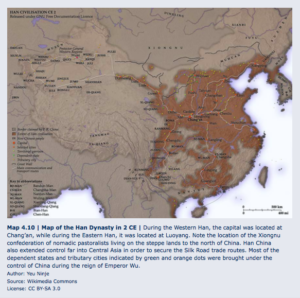
As opposed to studying a chronology of important events during these centuries, let’s consider the general picture for the political system and society of the Han Empire. The majority of people– as much as 90 percent of the population–were farmers, living out their lives in villages of a dozen to over 100 households. Some were independent farmers who owned small farms; some, tenants who leased land from owners of larger farms; and some, local magnates with large estates (see Figure 4.11). The government relied heavily on the first group for revenue and conscription and therefore tried to keep these owner-farmers in business with low taxes, relief in times of hardship, and improvement in their agricultural methods. Unfortunately, over the course of the dynasty, many farmers fell on hard times and were forced to sell their land to powerful landlords, thus becoming their tenants or even slaves. Landlordism thus became a major social and political problem, as local great families dominated ever more dependent poor, undermining the central government’s revenue base.
The remaining ten percent of the population lived in urban areas–the towns and cities of Han China–as artisans and traders or officials and garrison soldiers. By some estimates, the total population during these centuries hovered at 60 million, which means about six million were urban residents. Many cities, such as the capitals of both the Western and Eastern Han, had over 100,000 residents (see Map 4.10). The first imperial capital, Chang’an [chawng-an] (“Forever Peace”), was a walled city with twelve gates, watchtowers, market places, residential wards, administrative buildings and, of course, the imperial palace. Some of the agricultural produce, manufactured goods, and raw materials filling up the marketplaces testify to what artisans and traders were busy making, buying, and selling: cooked meats, pickled vegetables, fish, and grains; utensils and tools made of wood, brass, and iron; lacquer ware, jade, and furs; and textiles fashioned from silk and hemp. Imperial highways and lesser byways, and canals and other waterways, provided the routes for moving these goods both within and beyond China. Ever suspicious of the profit motive and believing in the foundational importance of the farmer, government officials supervised city markets and established agencies to regulate the most important industries.
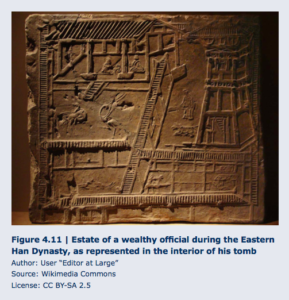
These commoner classes–farmers, artisans, and traders–were governed by a highly organized state and its corps of educated, professional civil servants. For administrative purposes, the empire was eventually divided into roughly 100 commanderies and 1300 counties. 130,000 officials constituted the bureaucracy. At the lowest level, working with village and town leaders, county magistrates handled such matters as tax collection, population registration, conscription for military service, law and order, and public works. They submitted reports to, and took orders from, commandery level military and civil officials, who then did the same with the nine ministries of the central government. These ministries handled such matters as revenue, justice, and foreign relations. The heads of each of these ministries, as well as two chancellors, routinely held audiences with the emperor to decide all policy matters. An independent branch of government, the censorate, audited the rest and reported directly to the emperor.
From the outset, the Han Dynasty inherited the Qin legalist system of government, with its emphasis on rational and efficient methods of administration and use of systems of rewards and punishments to promote order. However, early in the Han, Confucian scholars criticized Qin governing for lacking humaneness, and Han rulers increasingly saw the benefit of Confucian ideas to governing. This change was particularly the case with Emperor Wu [woo] (r. 141 – 87 BCE). During his reign, Confucius’s ideas were molded into an ideology that legitimated monarchy and a hierarchical social order. This ideology is called Imperial Confucianism. As an ideology, it simply provided a blueprint for how the political and social order should function.

Rulers saw the benefit in having officials who were highly educated, loyal, of good character, and who understood the formalities of ritual and etiquette. An Imperial Academy was founded at the capital in 124 so that students could be educated in classical Confucian texts, including the Analects. Across the country, these students were nominated by local officials based on their learnedness and virtuous conduct. Successful graduates went on to serve as officials, and, because that conferred the highest prestige and status on an individual in Han China, Confucian values penetrated society. Texts were compiled explaining good etiquette, conduct, and ritual requirements for each family member and members of society based on their superior or subordinate status. Filial piety was celebrated in both art and texts (see Figure 4.12), and law codes reinforced social norms by, for example, supporting the authority of the family patriarch, division of property among sons, and arranged marriages. In brief, over the course of the Han Dynasty, Chinese increasingly identified themselves as defenders of a Confucian civilization.
The emperor was at the pinnacle of both Han society and the political system, while the imperial family and in-laws constituted a privileged aristocracy. The emperor’s authority derived in theory from his having received the mandate of Heaven, his virtue, and his role as mediator between the celestial realms and human world; as such, he could expect his subjects’ obedience and loyalty. He resided within the walls of the imperial palace at the capital city, attended by eunuchs who handled his personal needs, palace administration, and the imperial harem. Emperors had numerous consorts but also a principal wife–the empress–who held a special status and was quite influential, usually because she bore the heir to the throne, but also because she and her in-laws were an intimate part of the emperor’s palace life. Often, the imperial family, imperial in-laws, eunuchs, and high officials broke apart into squabbling factions fighting for power and influence; this contention had deleterious consequences for the smooth functioning of the political system.
4.9.2 China and the Outer World during the Han Dynasty
Strengthened by its ever more confident political system and society, Han China also became an expansive empire, occupying and colonizing territory all along its borders. Sometimes this process was gradual: as migrants and merchants moved into neighboring areas, the government followed by setting up garrisons to protect them and eventually counties with civil servants to govern them. In other cases, armies were sent to subdue unstable borders or to secure trade routes. Regardless, as the dominant power in the region, China’s actions profoundly influenced and shaped the history of peoples and states in neighboring areas of Central and East Asia.
Traditionally, the biggest threats to the settled agricultural population of China came from non-Chinese nomadic pastoralists scattered about the steppe lands along the northern border (see Chapter Ten). These skilled horsemen and hunters tended their herds from horseback, resided in mobile campsites made up of yurts, and organized as tribes. These tribes usually selected the most skilled male warriors as their chieftains and also periodically organized into confederations so as to raid Chinese villages and towns (see Chapter Ten). During the Han, the most threatening confederation was knit together by Xiongnu [she-ong-new] (see Map 4.10). The founding emperor, Liu Bang, sought to subdue them with his armies but was defeated and forced to pay tribute and offer imperial princesses in marriage to their chieftains. Emperor Wu, however, enjoying a stronger government, sent massive armies of over 100,000 soldiers campaigning deep into Xiongnu territory, breaking up their confederation and forcing them to relocate. Although his armies suffered great losses, Emperor Wu established garrisons across the northern border to consolidate his gains and protect China.
As Emperor Wu brought the Xiongnu under control, he became curious about Central Asian territories lying to the west of China. Interested in finding allies that might support him in his efforts to control nomad confederations, he sent envoys on exploratory missions. They returned with news of trade routes extending from oasis city- states ringing the forbidding deserts of the Taklamakan Desert to countries lying beyond the Pamir Mountains. What they were speaking of were the earliest Silk Roads (see Map 4.11). Merchants had been using camels to carry such goods as silk from China to distant civilizations while bringing back gold, horses, and various handicrafts and foodstuffs. For that reason, beginning in 104 BCE, Emperor Wu dispatched armies to subdue the region as far as the Pamir Mountains, making the Han Dynasty overlords to Central Asian states, which were now obligated to send tribute and hostages. A frontier network of walls and watchtowers was then extended partway into the region. The Silk Roads were thus secured, and, because it could be conducted more safely, the volume of traffic grew. During the Han Dynasty, China demonstrated its intention of being a dominant player in Central Asia.
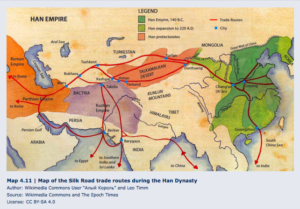
4.9.3 Conclusion: The Han Dynasty and Empires in History
These are some of the outstanding features of the Han Empire, and ones that can also be compared to other empires that existed at this time in other parts of the world, such as Mauryan Empire in India (see Chapter Three), Persian Empire in the Middle East (Chapter Five), or Roman Empire (see Chapter Six). Each empire conferred a special status on rulers, had an organized imperial administration with an educated civil service, maintained a large army to defend an expanding and increasingly well-defined territory, and developed an ideology and legal codes that justified authority and reinforced social order. Confident in the superiority of their organized governments, powerful militaries, and worldview, each of these empires proceeded to extend control over neighboring states and peoples.
4.10 THE PERIOD OF DIVISION, 220 – 589 CE
Like these other empires, the Han Dynasty also eventually fell. China was then divided up by independent, short-lived kingdoms until 589 CE, when the Sui Dynasty reunited most of the territory once controlled by the Han. Thus, for four centuries, during what is known as the Period of Division, China was politically unstable and racked by endemic warfare. Yet, in spite of the violence, these centuries also saw vibrant cultural developments, as Buddhism became an organized institutional religion reshaping the spiritual landscape.
4.10.1 Political History–From Three Kingdoms (220 – 280) and the Western Jin (265 – 317) to the Northern and Southern Dynasties (317 – 589)
During the second century CE, a combination of factors led to massive rebellions against the Han Dynasty by lower classes living in the countryside. Many once thriving, independent farmers who fell on hard times lost their land to powerful local families who used their political connections to amass large estates. A series of floods and droughts and the famines and epidemics they caused only worsened these farmers’ plight, and the government was ineffective in providing relief. During the later Han, government revenue had fallen because local magnates kept their growing estates off the tax rolls. Also, many later Liu emperors were mere youths dominated by quarreling factions of imperial in-laws and eunuchs, so the quality of governing declined.
Desperate to escape poverty and starvation, many villagers fled their homes or joined roving bandit gangs. Some rallied behind individuals who promised the dawn of a new age, thereby becoming part of large, militarized religious societies with political goals. One was the YellowTurbans, a society named after the yellow cloth members wrapped around their heads. The founder, Zhang Jue [jawng joo-eh], claimed he was a devoted follower of the legendary Daoist philosopher Laozi, who had by this time been deified and envisioned living in a Daoist heaven. Zhang accrued a following of disciples by instructing them in faith healing, establishing a rudimentary organization, and prophesying an impending apocalypse. He led his followers to believe that the apocalypse would be followed by an age of peace when the sky would turn yellow and all would be equal. The movement grew into the tens of thousands. Some followers proclaimed 184 CE was propitious, daubing the characters for that year in mud on the gates to government offices. The Yellow Turbans rebelled, and unrest spread across north China. Other similar millenarian religious movements followed.
The Han Dynasty was in crisis but lacked the strong leadership of earlier rulers like the founder Liu Bang or Emperor Wu. Youthful emperors were forced to rely on generals who commanded permanent standing armies around the empire as if they were private possessions. But by empowering military strongmen to suppress rebellions, Han rulers sealed the fate of the dynasty. Generals feuded amongst each other and competed to impose a military dictatorship on the court. Eventually, in 220 CE, one general deposed the Han emperor, but he failed to unite the realm because by that time the country had been divided up by three kingdoms and their rival warlords.
Within their realms, each warlord sought to strengthen his hand against the others by restoring order and establishing a functioning state. After all, they needed fighting men and revenue. Cao Cao (155 – 220 CE) was the most effective in achieving these goals. He was the adopted son of a Han court eunuch and eventually entered the military. As a commander, he earned his spurs leading Han armies against the Yellow Turbans. As the dynasty fell apart, he gained control over it and established a dictatorship in northern China. It was his son who removed the last Han ruler and established the Wei [way] Dynasty (220 – 265 AD), one of the Three Kingdoms (see Map 4.12).

By this time, as a result of the rebellions and civil wars, much land in north China had gone to waste. So Cao Cao turned it into huge state farms where he could settle his soldiers, landless poor, and, most importantly, tribes of nomadic herders from the steppe lands to the far north who had served him as he came to power. Thus, Cao rulers created colonies of farmers who supplied tax revenue
The Western Jin had reunified China, but that unity wasn’t to last. The policy of settling tribes of non-Chinese nomads in north China backfired. Among them, rebel chieftains rose up, carved out kingdoms of their own, and expanded their power all across the north. One Xiongnu chieftain, Liu Yuan [lee-oh you-anne], even declared he was a descendant of a Han Dynasty imperial princess and therefore had the right to restore the Han Empire. His son descended on the Western Jin court at Luoyang and eventually, in 317 CE, forced it to flee east to Jiankang [jee-an cawng] (today’s city of Nanjing).
China was again divided up among competing dynasties, a state of affairs that would persist until 589 CE, during a time referred to as the Northern and Southern Dynasties (317 – 589). Six successive Southern Dynasties were all located at Jiankang, and had as their base of power the Yangzi River and, as hereditary military families, soldiers for Wei armies. Such state-owned land and hereditary soldiers became the mainstays of warlord dynasties throughout this time.
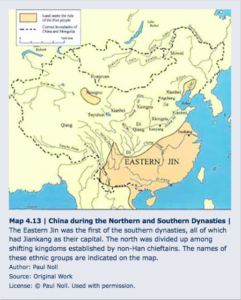
The two other kingdoms, Wu and Han, were located in the south. Over the course of decades, the ruling warlords of all three states fought each other in campaigns involving much treachery and stratagem. In 263 CE, the Han kingdom fell to the invading forces of Wei commanders. But then, just two years later, a powerful Wei family–the Sima– usurped the throne and changed the kingdom’s name to Western Jin [jean] (265 – 317 CE). The Western Jin conquered Wu in 280 BCE, thereby bringing to an end the Three Kingdoms period.
The Western Jin had reunified China, but that unity wasn’t to last. The policy of settling tribes of on-Chinese nomads in north China backfired. Among them, rebel chieftains rose up, carved out kingdoms of their own, and expanded their power all across the north. One Xiongnu chieftain, Liu Yuan [lee-oh you-anne], even declared he was a descendant of a Han Dynasty imperial princess and therefore had the right to restore the Han Empire. His son descended on the Western Jin court at Luoyang and eventually, in 317 CE, forced it to flee east to Jiankang [jee-an cawng] (today’s city of Nanjing).

China was again divided up among competing dynasties, a state of affairs that would persist until 589 CE, during a time referred to as the Northern and Southern Dynasties (317 – 589). Six Successive southern Dynasties were all located at Jiankang, and had their base of power the Yangzi River. basin (see Map 4.13). But their rulers were usually militarily weak and lacked revenue, due to southern China’s comprising a colonial frontier dominated by powerful families with large estates and private armies. These families highly valued their pedigrees, intermarried, and saw themselves as the heirs to Confucian civilization. At the southern court, they dominated high offices, thus constituting a hereditary aristocracy. The ruling family was always limited in power by their influence.

The situation was even more complex in the north during those three centuries. The kingdom established by Liu Yuan along the Yellow River was just one of numerous short-lived Northern Dynasties established by non-Chinese chieftains of different ethnicities. The Liu rulers, for instance, were Xiongnu, while others were of Turkic ancestry. At times, the north was divided among numerous, rival regimes, while, at others, it was unified. But all of these kingdoms shared similar characteristics. They were ruled by military dynasts who wanted to restore the Chinese empire. Their armies consisted of an elite, heavily armored cavalry drawn from aristocratic military families that was supplemented by Chinese foot soldiers (see Figure 4.13). They employed educated Chinese to serve as civil officials and administer their territories.
The Northern and Southern Dynasties came to an end in 589 CE after Yang Jian [yawng gee-an], a general hailing from the ruling clan of a northern kingdom, first established control over all of north China and then defeated the last southern dynasty. He ruled his new Sui [sway] Dynasty as Emperor Wen [one]. China was once again united under one dynasty (see Map 4.14).
4.10.2 China’s Third Great Tradition: The Introduction of Buddhism to China
Aside from the shifting configuration of kingdoms, perhaps the most notable development during the Period of Division was the introduction of Mahayana (“Great Vehicle”) Buddhism into China (for the development of Mahayana Buddhism, see Chapter Three). Beginning from the second century CE, at the end of the Han Dynasty, Buddhist merchants and monks from India and Central Asia brought their faith and scriptures to China by the Silk Roads and maritime trading routes (see Map 4.15). The impact was immense and can be compared to the Christianization of the Mediterranean region and spread of devotional forms of Hinduism in South Asia during this same period of time (see Chapters Three and Six). Historians estimated that by the time the Sui Dynasty reunited China four centuries later, China had approximately 33,000 Buddhist temples and two million monks and nuns. Buddhism had become a large-scale religious organization with these temples, clerics, and scriptures (see Figure 4.14), as well as a widespread popular faith capturing the imagination of common people and rulers alike.
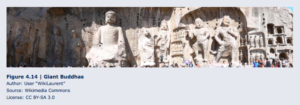
Historians have also hypothesized why this spread occurred. First of all, Buddhism clearly met a spiritual need. During the Period of Division, turmoil from rapid political change and constant warfare brought much suffering and instability to people’s lives. Now, here was a religion that explained their suffering with notions of karma and rebirth and also offered hope with paths to salvation and enlightenment. Buddhism placed the world amidst visions of multiple hells and heavens where merciful Buddhas and Bodhisattvas worked for the salvation of all beings.
Buddhism appealed to people in different ways. For scholarly elites living in capital cities or as hermits in mountain retreats, Buddhist doctrines about the nature of reality, self, and enlightenment were appealing because they seemed similar to concepts in Daoist philosophy. Both philosophies questioned the reality of ordinary understandings of the self and world, emphasized that our desires create an illusory world, and offered techniques for achieving liberation. Nirvana, for instance, was compared to the Dao (Daoist “Way”).
For rulers, Buddhism served political purposes. Since the faith became so popular, rulers who took vows and sponsored temple construction and the ordination of monks looked good because they were upholding the dharma, that is, the Buddhist law. Some even went so far as to have monks recognize them as incarnate Buddhas. Lastly, Buddhist monks–whether foreign or Chinese–were some of the most educated people at their courts and could assist rulers with mundane matters, like international relations, but also esoteric ones, such as spells and divination. Monks won support by promising that their rituals and incantations had magical potency.
Lastly, for most people, Buddhism was a devotional religion. Buddhas and Bodhisattvas were merciful beings to be worshipped because their good karma redounded to the benefit of all beings. By going to a temple and burning incense or praying and making offerings before a Buddha statue, the faithful might have a simple wish granted: an illness cured, loved ones helped, or a better rebirth ensured.
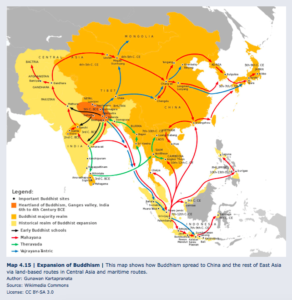
4.11 THE TANG DYNASTY AND THE EMERGENCE OF EAST ASIA 4.11.1 The Early Tang Dynasty
The Sui [sway] Dynasty did not last long (581 – 618 CE) and only had two emperors: Emperor Wen and Emperor Yang. Both envisioned recapturing the glory of the Han Dynasty; hence, they engaged in many construction projects and military campaigns. Immense capital cities were was created to connect the Yellow River to the Yangzi River. These emperors also believed that Manchuria and the Korean Peninsula were properly Chinese territory; therefore, they repeatedly launched enormous military expeditions to attack the most powerful Korean kingdom located there. Emperor Yang’s ground and naval campaign in 611 CE, for instance, required enlisting over one million combat troops and hundreds of thousands of additional men just to transport supplies. All of these campaigns met defeat.
What is more, that very same year, the Yellow River disasters combined with these emperors’ heavy demands led to widespread unrest, and the Sui Dynasty elites took matters into their own hands by organizing their communities for self-defense. After the emperor who was stationed along the northern border to defend against the steppe nomads, marched into Chang’an, where he declared the founding of the Tang Dynasty (618 – 907 CE). Emperor Yang’s life came to an end when he was assassinated by his own men.
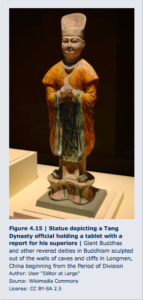
Like the Han Dynasty, the Tang was one of the most dynamic and long-lived dynasties in China’s history. That dynamism was made possible by how internally and then engaged in military expansion (see establishing solid political, economic, and military institutions. Fortunately, Tang rulers could draw upon nearly a millennium of historical experience going back to the Qin Dynasty, when a centralized monarchical political system governing all of China had at their disposal sophisticated ministries that in turn oversaw a vast provincial and county administrative system. To serve in high office, a man usually had to come from one of a small number of highly prestigious families with illustrious family pedigrees. These families took pride in their superior education and manners and maintained their exclusiveness by intermarrying. Thus, the Tang Dynasty was dominated by an aristocracy. Nevertheless, some men from a larger pool of locally prominent families entered the civil service based on merit, by graduating from colleges located at the capitals or succeeding at civil service examinations (see Figure 4.15).
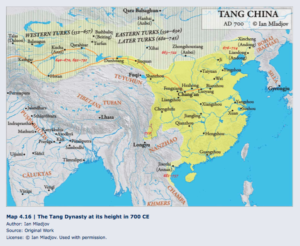
In earlier times, empires rarely flourished without a solid agricultural foundation and revenue base. To ensure sufficient grain and labor service, Tang rulers believed that land must be equitably distributed to farmers. So they implemented the equal fields system. In this system, each family was to receive an equal plot of land (adjusted for terrain and productivity) for life, as well as a smaller plot as a permanent possession. The former was for growing grain, and the latter, for hemp and mulberry trees. In exchange, each farming family had to pay a tax in grain and cloth and provide twenty days of labor service. To make this work, officials carried out censuses and land surveys and periodically redistributed land. Of course, this system was quite onerous and difficult to carry out in practice, but it did function well for about a century.
The Tang also flourished because special attention was paid to molding an orderly society through the promulgation of sophisticated law codes. From ancient times, in China, law was viewed as an expression of the will of the emperor, whose pronouncements defined illegal conduct and proper punishments for it. Also, law was critically important to maintaining order, not only in the social but also the natural world. Crimes committed both by subjects and the state could disturb the cosmos and lead to natural disasters. Thus, law maintained social and cosmic harmony. That is why codes were so important.
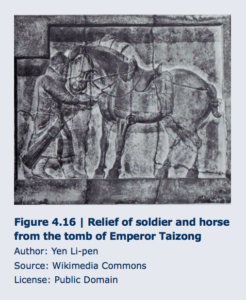
The Tang Code contains twelve sections, one addressing general principles, and the rest, administrative and penal law. Most of the statutes define criminal offenses and the punishment for each of them. The magistrate’s role, then, was primarily to investigate and determine precisely the nature of the crime so that the proper punishment could be assigned. In Tang times, people believed that the severity of punishment should be based on the relative status of the perpetrator and victim. For instance, a crime committed against a family member was more serious than one committed against a stranger, and a crime committed against an official was more serious than one committed against a commoner. Within families, too, the status of members mattered. Whereas a father could flog his son without consequence, a son faced capital punishment should he beat his father. In brief, Tang laws encoded the status hierarchy and values of imperial Confucianism. The most serious crimes were those committed against the emperor, country, senior family members, and social superiors. Nevertheless, those of higher status were held accountable for their actions; a magistrate who failed to justly administer the law faced punishment. In fact, Tang monarchs were so concerned that justice might fail to be upheld that they often proclaimed amnesties, nullifying the sentences of all but the worst criminals.
Lastly, Tang rulers established a formidable military. At first, the army consisted of six hundred militias stationed at headquarters located near the capitals and throughout the countryside, a large standing army located at the capital, and frontier garrisons strung out along the northern border. These forces were largely maintained by drawing men from a military population. That is, Tang rulers relied on a large number of families that maintained military traditions and provided sons for periods of service in lieu of paying taxes and providing labor service. As necessary, these men could be assembled into expeditionary armies consisting of heavy cavalry and marching infantry (see Figure 4.16).
Having laid these solid institutional foundations, the Tang Dynasty followed with military expansion. Offensives waged to the north divided up and subdued powerful Turkic khans and their confederations of steppe nomads. Tang imperial power was then projected deep into Central Asia, Manchuria, and northern Vietnam, making China the most dominant country in East Asia in the seventh and eighth centuries.
4.11.2 The Emergence of East Asia: The Case of Korea and Japan
In the introduction, we defined East Asia in both geographic and cultural terms, highlighting Korea and Japan. East Asia first emerges as an identifiable cultural sphere during the Tang Dynasty. By Tang times, kingdoms had already emerged on the Korean Peninsula and the main islands of Japan, but it was during the Tang that ruling elites in both of these states made extensive efforts to adapt components of the Chinese political, legal, and writing system, as well as of Chinese culture, to their own societies.
4.11.2.1: Korea’s History from the Fourth Century BCE to 900 CE
We have already learned about China’s history from the Han Dynasty (203 BCE – 220 CE) through the Period of Division (220 – 589 CE) and into the Tang Dynasty. During those same centuries, the first states formed on the Korean Peninsula, and historians generally organize that time into three periods: the early historical period (c. 400 BCE – 313 CE), Three KingdomsPeriod (313 – 668 CE), and the Silla Dynasty (668 – 892 CE).
By the fourth century BCE, the peninsula had already long been populated by peoples who had migrated there from northeast Asia and settled into agricultural villages. These peoples were not originally speakers of Chinese; rather, they spoke languages belonging to the Altaic language family, which possibly includes Korean. This point is important because people unfamiliar with East Asia sometimes think that the languages spoken by Chinese, Koreans, Japanese, and Vietnamese are closely related, when in fact they are quite different. However, it is also important to note that in ancient times throughout East Asia, the Chinese writing system was adopted by literate elites for the purpose of writing their spoken languages. Only over time were native scripts developed out of it.
The political picture for the early historical period is complex because the peninsula and neighboring Manchuria looked like a mosaic of chiefdom confederations and petty kingdoms, each governed by elite families living in walled towns. These polities first took shape during these centuries. By the early centuries CE, three kingdoms extending from Manchuria to where Seoul lies today (the capital of South Korea) covered the northern half, while the southern half was divided up by confederations of chiefdoms. The most powerful kingdom was Goguryeo [Ko-goo-ryo] c. 37 BCE – 668 CE).
The Korean peninsula lies very close to China, with only Manchuria and the Yellow Sea dividing the two states. Long before Korea’s early historical period, rulers of Chinese states had taken an interest in controlling both trade routes leading into this region and the peoples living there. In 108 BCE, during the Han Dynasty, Emperor Wu even sent expeditions into Manchuria and Korea. He opened up a corridor leading from China through Manchuria into the peninsula and established four commanderies to control the area (see Map 4.17).
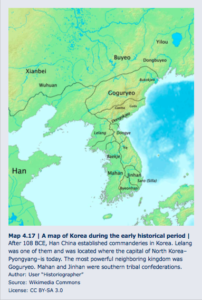
But Han China by no means colonized the entirety of this northeastern region. Kingdoms and tribal confederations remained to the east and south, most notably Goguryeo. After the Han Dynasty collapsed, northern China was in turmoil and unable to control these frontiers. In 313 CE, King Mich’on of Goguryeo, in an effort to expand the size of his kingdom, seized Chinese territory. That date marked the beginning of a new stage in Korean history referred to as the Three Kingdoms period (313 CE – 668 CE).
The Three Kingdoms were Goguryeo, Baekje [peck-jay], and Silla [she-la] (see Map 4.18). Like Goguryeo, the early histories of Baekje and Silla date back to the early historical period, during which time they were consolidated from southern chiefdom confederations (see Map 4.17). Each kingdom was
dominated by a warrior elite composed of the ruling and aristocratic clans. For most of the Three Kingdoms period, Goguryeo was the dominant military and political power, spreading its control over much of Manchuria and northern Korea. During the fifth century CE, its capital was moved to Pyongyang, site of a former Han Commandery. This move made this city–the capital of North Korea today–important to Korean history. Murals on Goguryeo tombs located in the vicinity show what this kingdom’s elites valued (see Figure 4.17). They are depicted as heavily-clad warriors fighting on horseback with bows and arrows, and swords and halberds. A cosmos depicts guardian spirits and nature gods belonging to a native Korean tradition of shamanism.
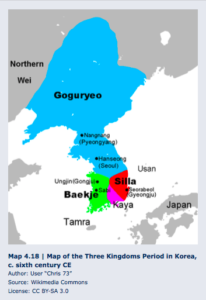
Given the geopolitical position of Korea, it is not surprising that all three kingdoms highly valued martial traditions. First of all, they fought with each other for control over territory and re-sources on the peninsula. Secondly, positioned as Korea is between China and Japan, those states often intruded upon peninsular conflicts. For all these reasons, Silla, Baekje, and Goguryeo monarchs readily borrowed ideas from China them more power. That borrowing in- cluded introducing elements of Chinese political institutions and legal traditions, as well as Buddhism and Confucianism. All of these kingdoms sent students to study in China and patronized Chinese Buddhist monks and learned Confucians who visited their courts. These visitors learning, including science and tech- nology. As we have seen, Buddhism not only promised salvation but also magi- cal powers of healing, and rulers could style themselves as living Buddhas. That is why they sponsored the building of temples and formation of a Buddhist religious order. Confucianism, on the other hand, provided models of civility, courtly etiquette, and bureaucratic governance for ruling elites, and rulers could style themselves in Chinese fashion as sovereign monarchs. Hence, Confucian academies were established to train students of aristocratic families for service.
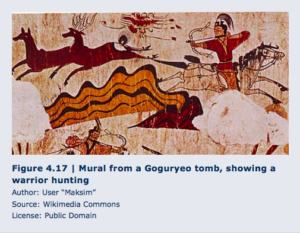
Towards the end of the Three Kingdoms period, however, it was not the great northeastern power of Peninsula. This achievement went to the Silla Dynasty and did so for two reasons. First, Silla rulers were political practices to centralize their power. They adopted Chinese-style titles, central government agencies, and law codes; made Buddhism a state-sponsored religion; and established an academy for studying Chinese classical texts, law, medicine, and astronomy. Second, Silla monarchs built alliances with Tang emperors that worked to their advantage. As we have seen, the Chinese Sui Dynasty fell because Sui rulers suffered terrible defeats at the hands of the armies of the great kingdom of Goguryeo. Tang Dynasty rulers continued the invasions but also failed. For that reason, they were open to building alliances with Silla and combining their military forces. Together, they defeated Baekje in 660 and Goguryeo in 668. Much to the Tang emperor’s surprise, Silla then drove out Tang forces, preventing any efforts on China’s part to control the Korean peninsula. The Silla Dynasty (668 – 892 CE) thus became the first one to unify the peninsula (see Map 4.16).
In sum, Goguryeo and the Silla Dynasty were, in succession, two of the most powerful kingdoms in ancient Korea. Their histories were deeply shaped by the intrusion of Chinese states into the region. For that reason, they can be categorized as instances of secondary state formation. Throughout history, some states developed and centralized their control over a territory largely in response to the impact of a powerful neighboring state that had developed before them. As they did so, they also borrowed ideas for how states should be organized from that neighboring power, even as native traditions and language are retained.
4.11.2.2 Japan from the Yayoi Period to the Seventh Century
Those who follow the history of World War II might know that, during those years, the highest authority in Japan was Emperor Hirohito. Even today, Japan has an emperor and empress, although they no longer have any formal political power in this now democratic nation and rather serve in a cultural and symbolic role. Interestingly, the Japanese monarchy is the oldest continuous one in the history of the world and traces its beginnings to at least the fourth century CE.
Japan’s early historical development presents unique characteristics because of its geography. The island archipelago was close enough to Chinese and Korean states to borrow from them away so that invasions were never a sudden impetus to change (see Map 4.1). Therefore, although we can also speak of secondary state formation for Japan, that is largely because of the conscious choice on the part of ruling elites to adopt political ideas and cultural patterns from China and Korea.
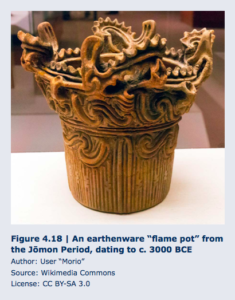
But even during the prehistoric period, geography impacted Japan’s development in hunter-gatherers dates back to c. 30,000 BCE. In the resource-rich environments of mountainous and forested Japan, small bands of mobile, multi-generational families were able to thrive on game, shellfish, fruits, tubers, and nuts. In fact, foraging strategies were so successful that even when sedentary village communities first formed, they thrived without agriculture. This period of time is known as the Jōmon [joe-moan] Period (c. 11,000 – 500 BCE). The archaeological record reveals that, up and down the archipelago, foragers had settled into permanent base camps. These were hamlet communities made up of pit dwellings for homes and raised floor structures for holding community functions. Jōmon, meaning “cord-marked,” refers to the type of pottery they used (see Figure 4.18). This case is one of the few in prehistory where a culture invented and used pottery long before farming.

Farming began during the next stage in Japanese history–the Yayoi [ya-yo-ee] Period (500 BCE – 250 CE). The label refers to a site near Tokyo where artifacts were discovered evidencing new developments in Japan. Most importantly, rice-paddy agriculture and dry-field farming were introduced, techniques that supported population growth and the formation of more and larger village communities. The impetus to agriculture was likely earlier experimentation with simple horticulture, a warming climate, and migration from mainland East Asia. Those migrants also brought knowledge of iron- and bronze-working; hence, tools and weapons fashioned from metals became widespread.
During the early centuries of Yayoi, small village communities proliferated across the main islands of Japan, but, during the latter half, they evolved into something more substantial. Archaeologists have excavated the foundations of large settlements surrounded by moats and embankments (see Figure 4.19). These fortified bastions were home to up to two thousand residents and contained ceremonial centers, differentiated residences and burials, watchtowers, and palisades. Some burials contained skeletons evidencing wounds or dismemberment. Combining this evidence with clues from contemporary Chinese historical sources, specialists have concluded that, by the end of the Yayoi period, powerful chiefdoms had emerged in Japan, and they were allying with and battling each other to control trade routes and territory.

In retrospect, the late Yayoi Period clearly was a transitional phase leading to the formation of the in the next stage, the Mounded Tomb Period (250 – 600 CE). Among the warring chiefdoms, one emerged as dominant. Hailing from the Kinai region of Japan (see Map 4.1), Yamato chieftains expanded their power through force and diplomacy, and eventually forged a kingdom (see Map 4.19). The principal evidence for their growing power are the massive, keyhole-shaped tombs giving this period its name (see Figure 4.20). In fact, nearly ten thousand tombs have been identified, but the largest ones belong to the Yamato rulers, the ancestors to the long -lived Japanese imperial line. Although the large royal ones have not yet been excavated, smaller tombs containing an abundance of horse trappings, iron weapons, and armor provide evidence that mounted warfare was introduced from the Korean peninsula, perhaps accelerating the pace of state formation.

As they conquered more territory, Yamato rulers devised strategies for strengthening their monarchy and incorporating leaders of the many powerful chieftain clans dominating local areas up and down the archipelago. For service at their royal court or as provincial officials, they granted them office and noble titles, thereby building a coalition of great clans. In addition, in the sixth century CE, burials contained skeletons evidencing wounds or dismemberment. Combining this evidence with clues from contemporary Chinese historical sources, specialists have concluded that, by the end of the Yayoi period, powerful chiefdoms had emerged in Japan, and they were allying with and battling each other to control trade routes and territory.
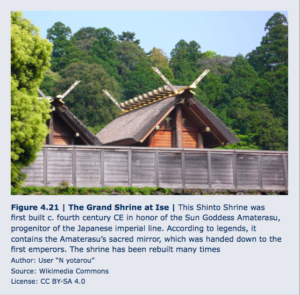
Yamato rulers began to study the great Sui (581 – 618 CE) and Tang (618 – 907 CE) Dynasties in China and to introduce reforms based upon what they learned. The next two centuries in Japanese history, the Asuka-Nara Period (c. 600 – 800 CE), was defined by these Chinese-style reforms, although the name itself refers to the successive locations of the royal court.
Prince Shōtoku [show-toe-coo] (573 – 621 CE) and Empress Suiko [sue-ee-ko] (r. 593 – 628) led the way by sending several embassies to the capital of China and then remodeling their capital and court. In his “Seventeen Article Constitution,” Shōtoku called for the introduction of Buddhism and Confucian ethics. His articles, for instance, stated that the sovereign’s relation to subjects was like Heaven’s to the earth, and his or her commands should thus be obeyed. Empress Suiko adopted the title “Heavenly Monarch,” thus shifting the character of the monarch from a martial king to
a Chinese-style sovereign. In brief, they introduced a Confucian-oriented, emperor-centered state ideology that clearly established a hierarchical system of ranks and norms for court etiquette. For the remainder of this period, other reformers and monarchs would only deepen the reforms by introducing Chinese-style law codes. These laws reshaped the government and land according to a bureaucratic and administrative structure very similar to that of Tang China.
Nevertheless, distinctly Japanese patterns remained throughout this time. First, the royally-recognized great clans of earlier times evolved into an aristocratic class that dominated the court and the upper ranks of officialdom. Secondly, in addition to establishing a council to manage the growing numbers of Buddhist temples and clerics, the court established a Council of Kami Affairs to oversee native Japanese religious traditions. That tradition is known as Shinto [sheen-toe], or the “Way of the Kami.”
Shinto began in prehistoric times as reverence for kami—spirits and deities associated with natural phenomena, such as the sun or moon. Really, anything mysterious might become a kami, including a mountain, charismatic ruler, or serpent. During the Yayoi and Mounded Tomb Periods, these kami became the subjects of myths that explained their origins and powers, and shrines were erected to house sacred objects symbolizing them. By properly purifying oneself, conducting rituals, and praying to a kami, an individual could avert a disaster and ensure his own or the community’s well -being. Also, clans would claim important kami as their guardian spirits and fashion stories about how their ancestors descended from them. In fact, Yamato monarchs claimed they were descended from the Sun Goddess Amaterasu, and constructed a shrine at Ise [ee-say] to house her kami body (see Figure 4.21). Finally, during the Asuka-Nara Period, the Yamato court developed a centralized system to keep track of and regulate Shinto shrines throughout its realm, thereby harnessing higher powers to support its claim to rule the land.
In sum, like Korea, Japan’s history was highly impacted by developments in China, even as native languages, traditions, and creative adaptation remained foundational to the unique identities of each. However, Korea was far more subject to the intrusion of Chinese states in the Korean Peninsula, something that did not happen in Japan. Rather, as the first state formed on the archipelago, ruling elites looked to China for ideas as to how the kingdom might be governed. In the course of doing so, they also introduced the great tradition of Mahayana Buddhism.
4.11.3 The Decline and Collapse of the Tang Dynasty
The Tang Dynasty reached its zenith during the eighth century under the reign of Emperor Xuanzong (r. 712 – 756 CE), but then went into decline. At first, the problem was overexpansion. Tang rulers had expanded the empire’s boundaries in nearly every direction, including far into Central Asia. To defend the northwestern border, a system of regional frontier commands was established, each with its own commander and professional army. The earlier system of militias and garrisons manned by hereditary military families declined.
This decline turned out to be dangerous. After one general, An Lushan, butted heads with the emperor’s chief minister, he marched his frontier army of 100,000 soldiers south to the capital, forcing the court to flee. An was eventually executed by his own men, and a Tang emperor returned to the throne, but the turmoil unleashed by this rebellion rendered the Tang Dynasty ineffective. During the ensuing turmoil, the empire shrank and Central Asia was lost (see Map 4.20). Also, both Tang supporters and pardoned rebels were granted military governorships, giving them control over provinces. Many then chose not to remit tax revenue to the central government, appointed their own subordinates, and designated their successors. They had, in effect, become warlords with their own loyal, regional bases.
Furthermore, as the political system decentralized in this way, the system of equitable land distribution collapsed. Thus, much like during the end of the Han Dynasty, landlords used their power and influence to build great estates. Large numbers of farmers ended up without land and survived only by joining bandit gangs or the ranks of warlord armies. When droughts and famine hit in the late ninth century, a massive rebellion broke out. The last Tang emperor was turned into a puppet by military commanders and eventually, in 907 CE, abdicated. China then entered yet another period of division until the Song Dynasty restored order in 960 CE.

4.12 THE SONG DYNASTY
Like every Chinese dynasty before it, the Song Dynasty (960 – 1279 CE) was born out of turmoil and warfare. After the Tang Dynasty fell, China was once again divided up by numerous, contending kingdoms. The founder of the Song, Zhao Kuangyin [j-ow kwong-yeen], was a military commander and advisor to the emperor of one of these kingdoms, but after he died and his six-year-old son came to the throne, Zhao staged a coup. He left the capital with his troops, ostensibly to fight enemies to the north. But just outside the capital, his troops instead proclaimed him emperor, a title he accepted only with feigned reluctance and after his followers promised obedience and to treat the child emperor and people living in the capital environs humanely. On February 3, 960, the child was forced to abdicate, and Zhao took the throne as Emperor Taizu [tie-dzoo]. He and his brother, the succeeding Emperor Taizong [tie-dzawng], ruled for the first forty years of a dynasty that would last over three hundred, laying the foundations for its prosperity and cultural brilliance. The Song Dynasty saw a total of eighteen emperors and is most notable for the challenges it faced from northern conquest dynasties, economic prosperity, a civil serviceexamination system and the educated elite of scholar-officials it created, cultural brilliance, and footbinding.
During the Song, China once again confronted tremendous challenges from conquests by military confederations located along the northern border. So threatening and successful were these that the Song Dynasty counted as just one of many powerful players in a larger geopolitical system in Central and East Asia. The first two northern conquest dynasties, the Liao [lee-ow] and Jin [jean], emerged on the plains of Manchuria when powerful tribal leaders organized communities of hunters, fishers, and farmers for war (see Map 4.21).

As their power grew, they formed states and conquered territory in northern China, forcing the Chinese to pay them large subsidies of silk and silver for peace. So Chinese rulers and their councilors were in constant negotiations with peoples they viewed as culturally-inferior barbarians under conditions where they were forced to treat them as equals, as opposed to weaker tribute-paying states in a Chinese-dominated world. At first, they used a combination of defensive measures and expensive bilateral treaties, which did make for a degree of stability. But a high price was exacted. Halfway through the Song, the Jin Dynasty destroyed the Liao and occupied the entire northern half of China, forcing the Song court to move south (see Map 4.22). To rule Chinese possessions, Jin rulers even took on the trappings of Chinese-style emperors and developed a dual administrative system. Steppe tribes were ruled by a traditional military organization, while the farming population of China was governed with Chinese-style civilian administration. The Song Dynasty thus constantly faced the prospect of extinction and was challenged in its legitimacy by rival emperors claiming the right to rule the Chinese realm.
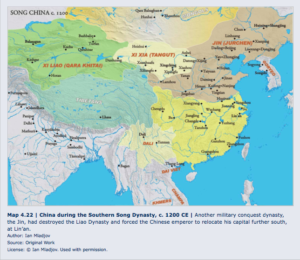
One reason Song monarchs were able to buy peace was the extraordinary prosperity during their rule and the resulting tax revenue made available. During those centuries, China was by many measures the most developed country in the world. In 1100 CE, the population was one hundred million, more than all of medieval Europe combined. That number doubled the population of 750 CE, just three hundred years prior. The reason for such growth was flourishing agricultural production, especially rice-paddy agriculture. More drought-resistant and earlier-ripening strains of rice, combined with better technology, lead to higher yields per acre.
The impact was enormous. The productivity of farmers stimulated other industries, such as ironworking. Estimates place iron production at as high as twenty thousand tons per year. That amount made iron prices low and, therefore, such products as spades, ploughshares, nails, axles, and pots and pans more cheaply available. Seeing its profitability, wealthy landowning and merchant families invested in metallurgy, spurring better technology. Bellows, for instance, were worked by hydraulic machinery, such as water mills. Explosives derived from gunpowder were engineered to open mines. Similar development of textile and ceramic industries occurred.
Indeed, during the Song, China underwent a veritable economic revolution. Improvements in agriculture and industry, combined with a denser population, spurred the commercialization of the economy. A commercialized economy is one that supports the pursuit of profit through production of specialized products for markets. A Song farmer, for instance, as opposed to just producing rice to get by, might rather purchase it on a market and instead specialize in tea or oranges. Since markets were proliferating in towns and cities and transport via land and water was now readily available, farmers could rely on merchants to market their goods across the country. To support this economic activity, the government minted billions of coins each year as well as the world’s first paper currency.

A denser population and sophisticated economy led to urbanization. During the Song, at a time when London had roughly fifteen thousand people, China had dozens of cities with over fifty thousand people and capitals with a half million. Song painted scrolls show crowds of people moving through streets lined with shops, restaurants, teahouses, and guest houses (see Figure 4.22).
To manage their realm, Song rulers implemented a national civil service examination to recruit men for office. Prior dynasties had used written examinations testing knowledge of Confucian classics to select men for office, but only as a supplement to recommendation and hereditary privilege. During the collapse of the Tang Dynasty, however, aristocratic families that had for centuries dominated the upper echelons of officialdom disappeared. The first Song emperor, Zhao Kuangyin, rode to power with the support of military men; having largely unified China, he then sought to restore civil governance based in Confucian principles of humaneness and righteousness. So he invited senior commanders to a party and, over a cup of wine, asked them to relinquish their commands for a comfortable retirement. They obliged. He and his successors consequently made the examination system the pre-eminent route to office, even establishing a national school system to help young men prepare for and advance through it. Thus, during the Song Dynasty, civil offices came to be dominated by men who had spent years, even decades, preparing for and passing through a complex series of exams. Hence, they were both scholars and officials. Success in entering this class placed a person at the pinnacle of society, guaranteeing them prestige and wealth. These scholar-officials, and their Confucian worldview, dominated Chinese society until the twentieth century.
In theory, since any adult male could take the examinations, the system was meritocratic. But in reality, because they were so difficult and quotas were set, very few actually passed them. Estimates suggest that only one in one hundred passed the lowest level exam. This ratio meant that, in order to succeed, a young man had to begin memorizing long classical texts as a child and to continue his studies until he passed or gave up hope. Only affluent families could afford to support such an education.
Nevertheless, the meritocratic ideal inspired people from all classes to try and so promoted literacy and a literary revival during the Song Dynasty. As a part of this revival and to provide a curriculum for education, scholar-officials sought to reinvigorate Confucianism. The philosophical movement they began is known as Neo-Confucianism. By the Song Dynasty, whereas Confucianism largely shaped personal behavior and social mores, Buddhist and Daoist explanations of the cosmos, human nature, and the human predicament dominated the individual’s spiritual outlook. Neo-Confucians responded to this challenge by providing a metaphysical basis for Confucian morality and governance. Zhu Xi (1130 – 1200), arguably the most important philosopher in later imperial Chinese history, produced a grand synthesis that would shape the worldview of the scholar-official class. He argued that the cosmos consists of a duality of principles and a material force composing physical things. One principle underlies the cosmos and individual principles provide the abstract reason for individual things. In human beings, principle manifests as human nature, which is wholly good and the origins of the human capacity to become moral persons. However, an individual’s physical endowment obscures their good nature and leads to moral failings, which is why a rigorous Confucian curriculum of moral self-cultivation based in classical texts like Confucius’ Analects is necessary. Most importantly, Zhu Xi argued, individual morality was the starting point for producing a well-managed family, orderly government, and peace throughout the world.
Furthermore, during the Song Dynasty, moveable-type printing also began to be widely used, contributing to an increase in literacy and broader exposure to these new ideas. Chinese characters were carved on wood blocks, which were then arranged in boxes that could be dipped in ink and printed on paper (see Figure 4.23). Books on a multitude of topics–especially classics and histories– became cheaply and widely available, fueling a cultural efflorescence at a time when education had become paramount to climbing the social ladder. Other inventions that made China one of the most technologically innovative during this time include gunpowder weapons (see Figure 4.24) and the mariner’s compass.
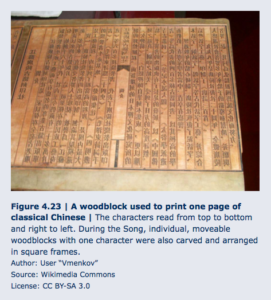
Looked at from many angles, then, the Song was truly a dynamic period in China’s history. However, some observers have bemoaned the fact that footbinding began during this dynasty and see that practice as a symbol of increasing gender oppression. Scholars believe footbinding began among professional dancers in the tenth century and was then adopted by the upper classes. Over time it spread to the rest of Chinese society, only to end in the twentieth century. At a young age, a girl’s feet would be wrapped tightly with bandages so that they couldn’t grow, ideally remaining about four-inches long. That stunting made walking very difficult and largely kept women confined to their homes. Eventually, the bound foot, encased in an embroidered silk slipper, became a symbol of femininity and also one of the criteria for marriageability (see Figure 4.25).
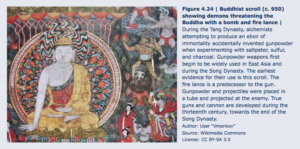
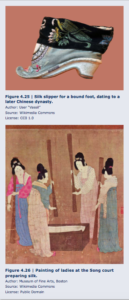
More generally, social norms and the law did place women in a subordinate position. Whereas men dominated public realms like government and business, women married at a young age and lived out most of their lives in the domestic sphere. Indeed, in earlier times, China was patriarchal, patrilineal, and patrilocal. It was patriarchal because the law upheld the authority of senior males in the household and patrilineal because one’s surname and family property passed down the male line—though a wife did have control over her dowry. Importantly, ancestor worship, the pre-eminent social and religious practice in Chinese society, was directed toward patrilineal forbears. That is why it was important for the woman to move into the spouse’s home, where she would live together with her parents-in-law. Patrilocal describes this type of social pattern. Marriages were almost always arranged for the benefit of both families involved, and, during the wedding ceremony, the bride was taken in a curtained sedan chair to the husband’s home where she was to promise to obey her parents-in-law and then bow along with her husband before the ancestral altar. Ideally, she would become a competent household manager, educate the children, and demonstrate much restraint and other excellent interpersonal skills.
Although gender hierarchy was, therefore, the norm, other scholars have observed that ideals were not always reality and women did exercise their agency within the boundaries placed upon them. A wife could gain dignity and a sense of self-worth by handling her roles capably; she would also earn respect. Song literature further reveals that women were often in the elds working or out on city streets shopping. Among the upper classes, literacy and the ability to compose essays or poetry made a woman more marriageable. For this reason, some women were able to excel. Li Qingzhao [lee ching-jow] (c. 1084 – 1155) is one of China’s greatest poets (see Figure 4.27). She came from a prestigious scholar-o cial family. Her father was both a statesman and classical scholar, and her mother was known for her literary achievements. In her teens, Li began to compose poetry, and, over the course of her life, she produced many volumes of essays and poems. Poems to her husband even suggest mutual love and respect and treating her as an equal. In fact, throughout Chinese history, it was not unusual for women to challenge and transgress boundaries. At the highest level, during both the Han and Tang Dynasties, we nd cases of empress dowagers dominating youthful heirs to the throne and even one case of an empress declaring her own dynasty.
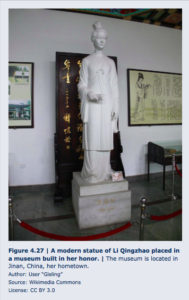
4.13 THE YUAN DYNASTY
The last major dynasty prior to China’s early modern period is the Yuan [you-an] Dynasty. Like earlier neighbors lying to the north of the Song, the Yuan was also a northern conquest dynasty. The key players here were steppe nomads living on the grasslands of Mongolia, known as Mongols, and their leader Genghis Khan. The story of their rise and how they created the largest territorial empire in the history of the world properly belongs to Chapter Eleven, which covers Central Asia, so we here only provide a brief introduction. The most important point to bear in mind is that the Mongols conquered many countries, including China, and incorporated them into a large Eurasian empire.
In the twelfth century CE, the Mongols were one of many tribes of nomadic pastoralists living on the steppes of Central Asia. Although these tribes were made up of peoples of differing ethnicity, they held in common a way of life. Since the steppe was unsuited to farming, they relied principally on their herds, but also on what they could obtain by trading with neighboring sedentary peoples. The nomads lived in temporary campsites, periodically breaking down their yurts and relocating as the seasons required. Since the tribes often fought with each other or turned to raiding, nomads were also excellent at mounted warfare. Their chieftain leaders–referred to as khans–were usually selected based on skill in battle and charisma.
Undoubtedly, the most famous khan in Central Asian history is Genghis Khan. In the late twelfth century, he accrued an army of loyal followers and began to subdue tribes across the Mongolian steppe. In 1206 CE, at a gathering of tribal leaders, he was proclaimed Universal Khan of a tribal confederation. Using a powerful military with a tight command structure, Genghis proceeded to unleash a wave of campaigning in northern China and Central Asia, thereby adding much territory to a growing Mongol Empire (see Map 4.23). After he died in 1227 CE, this empire was divided into four khanates, each of which went to one of his four sons as their territorial inheritance.

Tolui, Genghis Khan’s youngest son, was granted the Mongol homeland as well as subjugated territory in northern China held by the Jin Dynasty. But this rugged warrior died in 1232 at the young age of forty, so the task of managing Chinese territory fell to Tolui’s capable wife Sorghagtani Beki and her second son, Kublai Khan (1215 – 1294 CE). Unlike his predecessors, who largely treated Chinese as chattel and ruthlessly exploited their towns and villages, Kublai saw the advantages of taking a more enlightened approach. With the advice of Chinese advisors, he adopted Chinese-style methods for governing China. In fact, after Kublai was elected as the fifth Universal Khan in 1260, he chose to move his capital from Mongolia to Beijing, making it the center of his khanate. He then took on the trappings of a Chinese-style sovereign and, in 1273, declared the founding of the Great Yuan Dynasty. Accordingly, he asserted that the Mandate of Heaven had been transferred to him from the Song Dynasty.
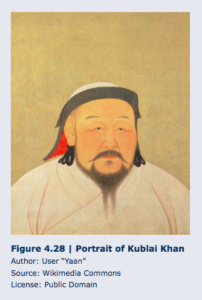
Kublai then engaged in a decade of conquest that concluded with the fall of the Song. This victory over the Song Dynasty, China required careful preparation. The Song was located in the southern two-thirds of China, where the terrain was matted with lakes, rivers, and canals.
The Mongols had little experience with naval warfare, so they turned to Chinese advisors to build a navy. Mongol cavalry boarded the ships and floated down rivers leading to the Song capital, laying siege to cities along the way. When they reached it in 1276, Kublai’s generals took the capital without bloodshed. The regent to the young Song emperor worked out conditions for surrender to them. Hence, the Mongol Yuan Dynasty had won control over China. After Kublai died, nine of his descendants ruled as emperors until the dynasty fell to native rebellions in 1368.
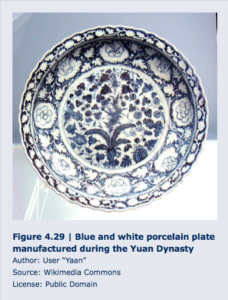
Historians differently assess the impact of Mongol Yuan rule on China. Earlier generations of historians judged that violent Mongol conquests devastated the land and led to a population drop. The Mongol style of rule was despotic. Rather than sustain the openness of Chinese society and use the merit-based examination system to bring talent into their government, Mongol rulers placed Chinese in rigid occupational categories and suspended the exams. Many capable men simply avoided offcial service and turned to other professions.
Recent studies, however, offer a more positive assessment. Because Yuan rulers followed the counsel of Confucian advisors and adopted traditional Chinese methods for governing, for most Chinese life went on as before. Early on, much attention was also paid to the farming population. To promote agriculture, Yuan rulers provided relief measures and promoted the formation of rural cooperatives. Also, Mongols highly valued crafts and implemented policies that greatly benefited artisans and promoted their work. Hence, arts such as textiles and ceramics flourished (see Figure 4.28). Finally, the assessment of Yuan rule in China should be linked to a broader assessment of the impact of Mongol rule on world history (see Chapter Eleven). While duly acknowledging the devastation caused by Mongol conquests, historians also find much merit in Mongol patronage of arts and support for constructions projects and advancements in the areas of medicine and astronomy. Most importantly, the massive Eurasian empire they forged initiated a new era of trade and contacts between Europe and China, as well as the regions lying between.
4.14 CONCLUSION
We have now passed through nearly four millennia of East Asian history. We prefaced that history with the development of Neolithic cultures leading up to the second millennium BCE, at which point the first kingdoms in Chinese history emerged. Longshan culture (3000 – 1900 BCE) consisted of competing chiefdoms that laid the foundations for the emergence of the first major states.
The first major state was the Xia Dynasty (c. 1900 – 1600 BCE). Although historians debate whether or not it was legendary and lack written sources from that time, the archaeological evidence points to a Bronze Age civilization with a capital city at Erlitou. The next dynasty, the Shang (c. 1600 – 1046 BCE), brings us into history proper, because we have written evidence in the form of oracle bones and bronze inscriptions. The last Shang capital was located at Anyang on the North China Plain near the Yellow River. The dynasty’s most important legacies were the earliest form of Chinese writing and ancestor worship. The oracle bones were used to divine the will of higher powers and the spirits of deceased Shang kings.
The next dynasty, the Zhou Dynasty (1045 – 256 BCE), began when chieftains to the west of the Shang declared themselves kings and overthrew it. They justified doing so with the Mandate of Heaven, which states that a higher power withdraws its support from corrupt ruling families and transfers it to righteous ones. Because it lasted eight hundred years and saw much change, the Zhou is divided into two major periods, the Western (1045 – 771 BCE) and Eastern Zhou (770 – 256 BCE). During the Western Zhou, Zhou kings ruled by granting land and noble titles to kinsmen and allies in exchange for loyalty and service. The resulting political system, which saw China divided up by over one hundred feudal states, is known as Zhou feudalism. During the Eastern Zhou, this nobility became increasingly independent and fought with each other for power and territory. A few declared themselves kings and forged powerful militaries by gearing their kingdoms for war. In the end, in 221 BCE, the state of Qin prevailed, initiating China’s imperial era. Also, in the midst of the dislocation caused by Eastern Zhou instability, three of China’s major philosophical traditions emerged: Confucianism, Legalism, and Daoism.
The short-lived Qin Dynasty was followed by the much longer lasting Han Dynasty (202 BCE – 220 CE). During the Han Dynasty, Confucianism was adopted as the governing philosophy and also penetrated society, shaping the Chinese worldview. The Han also became an empire, as borders were expanded in all directions. During the reign of Emperor Wu (141 – 87 BCE), China extended control over parts of Korea, northern Vietnam, and also much of Central Asia. The resulting stability and the productivity of the economy spurred the development of the Silk Routes.
After the Han dynasty fell, China was divided up by independent, short-lived kingdoms until 589 CE, when the Sui Dynasty reunited most of the territory once controlled by the Han. Thus, for four centuries, during what is known as the Period of Division (220 – 589 CE), China was politically unstable and racked by endemic warfare. Yet, in spite of the violence, these centuries also saw vibrant cultural developments, as Buddhism became an organized institutional religion reshaping the spiritual landscape.
The Tang Dynasty (618 – 907 CE) was yet another long-lived one in Chinese history. Tang rulers built an empire on the foundations of solid political and legal institutions, agricultural policy, and a formidable military. Also during the Tang Dynasty, East Asia first emerged as an identifiable cultural sphere. By Tang times, kingdoms had already formed on the Korean Peninsula and the main islands of Japan, but it was during the Tang that ruling elites in both of these states made extensive efforts to adapt components of the Chinese political, legal, and writing system, as well as of Chinese culture, to their own societies. During the seventh century CE, the Silla Dynasty unified the Korean Peninsula, and the Yamato heavenly sovereigns unified much of Japan. Two other unique East Asian civilizations had taken shape.
The last major dynasty surveyed was the Song Dynasty (960 – 1279 CE), one that is notable for the challenges it faced from northern conquest dynasties, its economic prosperity, and the civil service examination system and the educated elite of scholar-officials it created. Also, since footbinding developed during the Song, we considered the status of women in Chinese society, where gender hierarchy was the norm.
The Song Dynasty ended with Mongol conquests in 1279 CE. The Mongol Yuan Dynasty made China one part of a much larger Eurasian territorial empire. Mongol ruled lasted until 1368 CE, when native rebellions overthrew a faltering Yuan state, initiating a new period in Chinese history: the Ming Dynasty. This dynasty properly belongs to early modern history.
4.15 WORKS CONSULTED AND FURTHER READING
Barnes, Gina L. State Formation in Japan: Emergence of a 4th Century Ruling Elite. London and New York: Routledge, 2007.
Benn, Charles. China’s Golden Age: Everyday Life in the Tang Dynasty. Cambridge: Oxford University Press, 2002.
Ebrey, Patricia. The Inner Quarters: Marriage and the Lives of Women in the Sung Period. Berkeley: University of California Press, 1993.
Ebrey, Patricia, James B. Palais, and Anne Walthall. East Asia: A Cultural, Social, and Political History.
Boston: Houghton Mifflin Company 2006.
Hardy, Grant and Anne Behnke Kinney. The Establishment of the Han Empire and Imperial China.
Westport, CT: Greenwood Press, 2005.
Hwang, Kyung Moon. A History of Korea. Palgrave Macmillan, 2010.
Keally, Charles. “Jōmon Culture.” http://www.t-net.ne.jp/~keally/jomon.html
Keally, Charles. “Kofun Culture.” http://www.t-net.ne.jp/~keally/kofun.html
Keally, Charles. “Yayoi Culture.” http://www.t-net.ne.jp/~keally/yayoi.html
Kuhn, Dieter. The Age of Confucian Rule: The Song Transformation of China. Cambridge: Harvard University Press, 2009.
Lee, Ki-baik. A New History of Korea. Cambridge: Harvard University Press, 1984.
Lewis, Mark Edward. China between Empires: The Northern and Southern Dynasties. Cambridge: Harvard University Press, 2010.
Lewis, Mark Edward. China’s Cosmopolitan Empire: The Tang Dynasty. Cambridge: Harvard University Press, 2009.
Lewis, Mark Edward. Sanctioned Violence in Early China. Albany: Statue University of New York Press, 1989.
Li Feng. Early China: A Social and Cultural History. Cambridge University Press, 2013.
Loewe, Michael. Everyday Life in Imperial China. Indianapolis: Hackett Publishing, 2005.
Mote, Frederick. Imperial China,900 – 1800. Cambridge: Harvard University Press, 1999.
Peers, C.J. Soldiers of the Dragon: Chinese Armies 1500 BC – AD 1850. Oxford: Osprey Publishing, 2006.
Pines, Yuri et al. eds. Birth of an Empire: The State of Qin Revisited. Berkeley: University of California Press, 2014.
Robinet, Isabelle. Taoism: Growth of a Religion. Stanford: Stanford University Press, 1997.
Rossabi, Morris. “The Mongols in World History.” http://afe.easia.columbia.edu/mongols/index.html
Tanner, Harold M. China: A History, Volume I: From Neolithic Cultures through the Great Qing Empire.
Indianapolis: Hackett Publishing Company, 2010.
Temple, Robert. The Genius of China: 3,000 years of Science, Discovery and Invention. Rochester: Inner Traditions, 2007.
Totman, Conrad. A History of Japan. Oxford: Blackwell Publishers, 2000.
4.16 LINKS TO PRIMARY SOURCES
China
http://afe.easia.columbia.edu/
Confucius – the Analects selections and complete online editions. http://acc6.its.brooklyn.cuny.edu/~phalsall/texts/analects.html (selections) http://www.olemiss.edu/courses/inst203/confucianthought.pdf (selections) http://www.indiana.edu/~p374/Analects_of_Confucius_(Eno-2015).pdf (complete text)
Empress Wu Zetian and women during the Tang Dynasty http://www.womeninworldhistory.com/toc-06.html
The Laozi (Dao de jing) selections and complete online editions. http://afe.easia.columbia.edu/ps/cup/laozi_daodejing.pdf (selections) http://ctext.org/dao-de-jing (complete text) http://www.indiana.edu/~p374/Daodejing.pdf (complete text)
Mandate of Heaven
http://acc6.its.brooklyn.cuny.edu/~phalsall/texts/shu-jing.html
http://afe.easia.columbia.edu/ps/cup/classic_of_odes_king_wen.pdf
Mongols and the Mongol Yuan Dynasty http://afe.easia.columbia.edu/mongols/index.html
Oracle Bones of the Shang Dynasty http://afe.easia.columbia.edu/ps/cup/oracle_bone_general.pdf
Sunzi’s (Master Sun’s) Art of War
http://afe.easia.columbia.edu/ps/cup/sunzi_art_of_war.pdf (selections)
http://classics.mit.edu/Tzu/artwar.html (complete text)
Japan
Prince Shōtoku’s Constitution
http://afe.easia.columbia.edu/ps/japan/shotoku.pdf
Yoshinogari (a Yayoi Period archaeological site)
- Authored by: George L. Israel. Provided by: World History - Cultures, States, and Societies to 1500. Located at: http://oer.galileo.usg.edu/history-textbooks/2/?utm_source=oer.galileo.usg.edu%2Fhistory-textbooks%2F2&utm_medium=PDF&utm_campaign=PDFCoverPages. License: CC BY-SA: Attribution-ShareAlike

